MEET




















MEET




















C-stores and gas stations will have a significant role in driving electric vehicle adoption in Canada, and are positioned to profit from doing so
BY TOM VENETIS
LET’S GET RIGHT to the point.
Regardless of what some may be saying in the media, electric vehicles (EVs) and plug-in hybrid electric vehicles (PHEVs) are here to stay; and will only grow in numbers.
To give some perspective: according to Statistics Canada, in the first half of 2022, electric vehicle sales in Canada grew by one-third, and in 2022, achieved a six-month record, with nearly 56,000 units sold, a 35% increase from 2021. In the third quarter of 2022, all provinces and territories (except Prince Edward Island) saw double-digit increases in zero-emission vehicle (ZEV) registration. Also, 2023 was notable in that the Canadian ZEV volume was some 13.1% higher than in 2022 for a total of 184,600 vehicles registered. Reflecting on the latest data covering the first quarter of 2024, 46,744 new ZEVs (light and medium duty only) were registered across Canada. From that total number, 34,105 were BEVs and 12,639 were PHEVs. This represents 11.2% of the market share. Hybrid electric vehicle (HEV) registration hit 34,930 in the first quarter of 2024.
The adoption of fully electric and PHEVs and HEV’s will only continue to increase. It is important to remember that the Canadian government has made very clear it is committed to achieve 100% zero-emission vehicle sales by 2035 for all new light -duty vehicles, including interim targets of at least 20% by 2026 and at least 60% by 2030, as was announced in Canada’s 2030 Emissions Reduction Plan. These
targets were then incorporated into Canada’s Electric Vehicle Availability Standard as finalized in December 2023.
If there is one barrier that continues to cause concern for potential buyers of electric and hybrid electric vehicles, it is where to charge them when not at home. As J.D. Power noted in its second annual J.D. Power Canada Electric Vehicle Consideration (EVC) Study, “among consumers in the Canadian market who say they will not consider an EV for their next vehicle purchase, limited driving distance per charge is the most frequently cited obstacle to consideration (63%). It is followed by purchase price (59%) and lack of charging station availability (55%).”
This worry over the lack of places to charge was confirmed in the 2024 Mobility Trend Report published by Volvo Canada: Amongst the 1,000 Canadians surveyed online between March 26-28, 2024, “nearly four in five (78%) agree there currently isn’t enough publicly available charging infrastructure to make electric vehicles a good option.”
This presents an opportunity for Canadian convenience stores and gas stations—and those operating both in the same location—to ease that charging anxiety.
“According to NRCAN, as of July 11 there were 11,628 station locations with 29,033 charging ports in Canada,” says Jean-Christophe La Forge, marketing manager with Flo, a provider of electric vehicle charging solutions. “Late last year, NRCAN estimated that depending on the availability of home charging, Canada will need between 442,000 and 469,000 public charging ports by 2035.”
Already, Flo has installed some 2,700 public stations with more than 7,300 public charging ports in Canada, located in malls, parking lots, universities, convenience stores and restaurants. More will certainly be needed in the coming years to meet the growing number of electric and hybrid electric vehicles that will come onto Canadian roads, and to overcome that charging point anxiety that Canadian continue to have.
“At a national level, we are continuing to see growth in the charging market,” says Mike Mackay, EV charging specialist and senior technical support with National Energy Equipment. “The density and locations vary by region, but we are starting to see more retailers get into EV charging in various capacities. The most visible are the national companies like Suncor, Parkland, and Circle-K continuing to invest in their charging infrastructure. Parallel to this stream, we are seeing some sectors electrifying their fleets and installing behind-the-fence infrastructure to support those purchases.”
The challenge is getting those chargers into place.
Chad Bass, director of product management for electric vehicle charging for Dover Fueling Solutions, a part of Dover and a provider of customer-focused technologies, services and solutions in the fuel and convenience retail industries in North America, says the installation of charging infrastructure can be difficult or easy depending on the location. A new location has fewer issues as the fuel and convenience store operator likely is “working directly with construction companies, designers, technology providers etc. to put the needed infrastructure in,” he continues. “And what I’ve been telling those store owners and corporations is that even if you don’t plan on installing chargers immediately, at least build in the [electrical conduits] that you will need so when it comes time to put chargers in, it’s easy as pulling copper through the conduits and you don’t have to rip up your parking lot, sidewalks, drives and all that.”
He says with an existing site, there are challenges, as one does not have a clean slate to work with. In turn, operators will need to first work with local authorities to make sure all the necessary permits and building regulations are followed and will likely need to work with the
municipality’s energy provider to ensure that the right electrical infrastructure is put in place to support the chargers needed.
“A common barrier for c-stores and gas stations looking to install EV charging infrastructure is space,” adds Flo’s La Forge. “First, fuel retailers need to have parking spots available and allocate them to EV charging, while keeping enough space for trucks carrying gasoline to maneuver safely. Second, they need to take into consideration where the tanks holding the fuel are located and allow for sufficient clearance with the EV chargers.
“When selecting hardware, fuel retailers can choose an all-in-one DC fast charger that takes up less space than a dispenser-type charger that requires a power cabinet and involves more trenching. Another challenge fuel retailers will face when installing EV chargers is access to power. Direct-current (DC) fast charging requires access to 480-volt threephase power. We always recommend reaching out to your local utility early in the process.”
The two biggest hurdles are power availability and cost, concurs Mackay. “With this being fairly new technology, the economies of scale haven’t really taken hold yet, but we are starting to see reduction in equipment cost. The technology and companies providing it are evolving rapidly and these advancements are enabling increases in capability with decreasing cost. Lock step with these advancements, auto manufacturers are increasing the capabilities of the vehicles. As these advancements progress the ideal charging solution also progresses. Two-three years ago, a 50kw charger would meet the capabilities of virtually all vehicles on the road. Today there are multiple vehicles charging with peak power between 240kw—360kw. Additionally, for locations that serve medium or heavy duty vehicles, new standards are soon being launched that will see charging speeds an order of magnitude higher.”
Some might ask will making such an investment in electric vehicle chargers be worth the cost. Let’s be honest, while the cost of chargers is falling, to put in a sufficient number, and the work associated with doing so, might seem too much for the number of electric vehicles on the road right now and what is expected in the next few years.
The reality is that having EV chargers on-site has the potential to bring in significant revenues and business. Why? Charging takes time and the time spent charging that vehicle is a prime opportunity to bring those vehicle owners into the convenience store and drive sales.
In Charging the Future: The Role of Retail in Our EV Transition, the report’s author notes: “Retailers have strong economic incentives
to install EV chargers. A policy brief by Atlas Public Policy and the Retail Industry Leaders Association found that hosting an EV charging station ‘offers a range of potential benefits for retailers, including direct revenue from charging station use, increased sales, and improved corporate branding.’”
An analyst at energy consulting firm Wood Mackenzie more recently gushed that, “there is so much opportunity in the brick-and-mortar segment” because of its “synergies with EV charging.” Indeed, one charging network found that customer “dwell time” (the amount of time that a shopper spends in a store) increased by an average of 50 minutes, with an average spend of $1 per minute, following the installation of Level 2 EV charging equipment at a major retailer. A different network found that 89% of EV drivers make a retail purchase while charging.
EV chargers are a great fit for gas and convenience locations, emphasizes Mackay. “Gas stations already utilize the distribution of energy (gas and diesel) to draw customer traffic for their on-site convenience, car wash, and food offerings. EV charging does the same thing but has the added benefit of a little longer dwell time. Where a customer might be fuelling their vehicle for six minutes, an EV driver will typically be on-site for 15-30 minutes with the highest speed chargers. This makes the additional on-site amenities more important and attractive to EV drivers. Additionally, you are retaining loyal customers who will typically have both ICE (internal combustion engine) and BEV (battery electric vehicle) or PHEV (plug-in, hybrid electric vehicle) vehicles in their family and attract different clientele.”
And according to a recent paper from Boston University and University of Wisconsin-Madison researchers, locating a Tesla Supercharger near a retailer increases monthly visits by 4% on average, and grows revenue by 5%.”
“I think it’s important to note that when you have an EV driver at a location, the average charge time, what we’re seeing is around 25 minutes,” says Bass. “So, you have a captive audience there for 25 minutes and being able to provide them with an experience, one that is going to benefit [the store] more. As opposed to somebody that’s just fuelling up with gas or diesel, they’re in and out in about five minutes. So, you very much have a captive audience for almost three to four times longer.”
“Strategically located with extended hours and a broad product offering, convenience stores equipped with Level 3 EV charging stations (also known as DC fast chargers) are positioned to attract a steady flow of traffic from drivers seeking to replenish their vehicle’s battery while refueling their bodies,” adds La Forge. “The relationship between EV charging and convenience stores expands beyond foot

traffic, as studies have shown a revenue increase of 5% within the retail locations that install DC fast chargers. This indicates that EV drivers tend to spend more time and money at establishments with charging facilities.”
Mackay agrees. “With liquid fuels, the gas station is typically a local community service. Customers tend to be geographically nearby and may grab lotto or a pack of gum while fuelling up on the way home, unless it is a highway location. EV drivers typically use public charging infrastructure when they are not near their home. Most EV drivers have charging capability at their home, so they are stopping at convenience charging locations, like gas stations, where they are more likely to also be interested in on-site restaurants, road trip snacks and beverages, washroom amenities, etc. Given the difference in use case, it’s likely that more EV charging customers will have ancillary purchases than liquid fuels customers.
“As we start to see most of the national companies getting into this segment, delaying too long could lead to a loss of loyal customers who transition to EV. Regardless of a customer’s preferred retailer, once they move to EV, the priority becomes where are the most capable and reliable charging stations. Since there is not plentiful infrastructure in most of the country, brand loyalties are less relevant at this early stage and need to be re-established.”
Timing is everything, add Mackay. “From another perspective, this new industry means there are still many government incentives to help early movers get involved. These incentives won’t last forever but there is federal funding available right now and some provinces go above and beyond that funding, which makes the capital investment significantly more attractive.” OCTANE
For the the latest news about EV charging in Canada, plus a Q&A with NEE’s Mike Mackay, visit the EV section of CCentral.ca



















How to refurbish fuel station islands and make them look new again using a less costly, more sustainable method that won’t disrupt day-to-day operations.
bout five years ago, a customer had a bold request for the team at Countryside Concrete Service—do a full makeover of my fuel station islands without interrupting business or inconveniencing customers. It was a challenging ask.
Typically, refurbishment is a six to eight-week process for four islands at a cost of about $10,000 per island. It requires shutting down gas pumps, heavy equipment to tear up the existing structure, plus time and money to take piles of debris to a landfill site. There had to be a faster, more cost-effective way for giving pumping stations a fresh, attractive new look that customers will appreciate.
Company CEO Marco D’Alfonso and President Augusto D’Alfonso were determined to come up with a better solution for their client. They tried many different products and systems until, on the 28th attempt, they came up an option that ticked all the boxes. They created the System 28 Wrap, a patented, modular method that uses stainless steel bands that can be affixed to existing islands—even ones that are rusted, pitted and in poor shape. The makeover comes at a price that is about 50% less than traditional methods. The cost savings are substantial.
Finally, concrete surfaces receive a clean-looking finishing touch— a grey, topcoat of a specially formulated, non-slip paint that is easy to maintain with just soap and water. Refurbishment takes as little as a few hours to complete to a couple of days for a complete redo of a four-island station.
While a skilled crew installs the System 28 Wrap, it’s business as usual with minimal downtime and no inconvenience to customers. There’s no hot work involved on-site, making the refurbishing process safer for all. Another big plus: the stainlesssteel bands come in a variety of shapes and lengths to suit a wide range of existing fuel station islands. The bands can also be fully customized to suit any configuration. The modular nature of System 28 means that pieces can be easily and quickly replaced should they become damaged.
Clients across Canada, from large retailers like 7-Eleven to independents, are discovering the advantages of the System 28 Wrap. They appreciate the fact that it’s a more sustainable, environmentally friendly option. The old, more expensive and time-consuming method created mounds of concrete and steel waste generated from ripping out unsightly fuel station islands. With this new system, demolishing existing stations is not required, resulting in a cleaner worksite that minimizes disruption to your business and customers.

Only Countryside Concrete Services offers the one-of-a-kind System 28 Wrap. It’s a family owned and operated business with its home base in LaSalle, Ont. Backed by experience, knowledge and professionalism, you can feel confident about its team of skilled experts who take pride in the superior quality of their work. The before-and-after photos speak for themselves. Battered, old fuel islands transform from tired to tidy and neat using a seamless process. The results are remarkable, sure to create an inviting environment that will please your clientele and make you proud of your business.
Let the professionals at Countryside Concrete take care of the complete refurbishment of your gas station’s fuel islands wherever they are located across Canada and the United States. To learn more about how the System 28 Wrap and its ability to transform the look of your business, scan the QR code or visit ccs28.ca.
As competition heats up and loyalty programs evolve, think of personalized engagement as the big kahuna when it comes to driving member satisfaction
BY TOM VENETIS

LOYALTY PROGRAMS ARE everywhere now, with new ones seeming to be launched almost everyday. Each clamour to bring consumers to use them, with claims made for the worthwhile offers, savings and rewards one will have when signed up.
With so many loyalty programs on offer today, let’s examine what loyalty program needs to do now to stand out and not only attract, but also engage consumers to keep them coming back for more.
Paytronix’s Loyalty Trend Report 2024: Realizing Loyalty’s Full Potential, finds well-functioning loyalty programs are an effective means of engaging customers and critical for strategic growth. When the report’s authors looked closely at three key market segments—quick-service restaurants (QSRs), elite full-service restaurants (FSRs) and convenience stores—sustained loyalty success came down to not only retaining engaged members, but also acquiring new members.
“The highest-performing quick-service restaurants (QSRs) achieve an average 62% monthly loyalty program member retention rate, while elite full-service restaurants (FSRs) retain 58% of their loyalty program members month-to-month, on average. C-stores lead in this area, with top performers (90th percentile) reaching an 85% average retention rate,” according to the report.
When it comes acquisition, the QSRs sign up an average of 110 new loyalty members per store each month, FSR acquire 70 new members per location monthly, and c-stores add an average of 36 new members per location each month, the study adds.
Well-functioning loyalty programs also increase spend per visit. The study finds that at QSRs, the spend can range from US$19.05 to US$30.16, with FSR members increasing their spending anywhere between US$39.35 to US$77.49 and c-store loyalty program members increasing their spend per visit between US$13.03 to US$24.30.
If loyalty programs can be this successful, then why are many existing and potential members so disappointed with existing programs?
Boston Consulting Group’s (BCG) Loyalty 2.0—Making Loyalty Pay finds that today’s loyalty program users want the programs they are participating in to provide at least two key functionalities: more value and more personalization, with 73% of consumers expecting companies to understand their unique needs and expectations.
Kevin Farley, chief client officer with Impact21, a consulting firm specializing in retail, convenience, and energy clients, says many loyalty programs fail to utilize customer information and buying habits and patterns to create targeted and personalized offerings. He gives the example of a loyalty member who regularly buys gasoline at a location with a convenience store in which the member also buys food.
“If you are at the pump and you receive an offer for soup at the store, only you have never eaten soup or purchased soup there, that is a wasted promotion. It becomes noise as it is not about you or your preferences. You have now lost that consumer because that promotion is not tailored to them, as the program has not identified you as a certain type of consumer or what your preferences are.”
Generic programs fail to do what a company wants from a loyalty program, that is to change a customer’s buying behaviour. That can be anything from encouraging them to spend more or to incentivize them with offers that meet their expectations or anticipate their needs. A generic program treats all customers the same way and views them the same way.
“Everybody says ‘If I put in a loyalty program I’m going to have more loyal customers,’” says Donald Frieden, CEO of P97, a provider of cloud-based mobility services platform for mobile commerce, digital marketing, and consumer engagement for convenience retail and other companies. “Having a loyalty program does not mean I’m changing a customer’s behaviour. I need to do more than get them onto a platform. I need to get them onto the platform and then to engage with them.”
This can only come from companies using the vast amounts of data they collect from their loyalty members to give them offerings that are tied directly to their buying habits and purchasing behaviours in the real world.
“So, if you determine that generally I am going to buy a coffee up until noon, giving me a coffee ad or offering for a coffee in the afternoon is going to be worthless, and I may even grow frustrated if you load me up with ads and offers the are not relevant to me,” says Frieden. “What programs need to do is really leverage the data they have, to analyze it and then to create offers that are hyper-personalized to me.”
As the Paytronix study emphasizes, programs need to match what each individual member craves. This could mean offering monthly subscriptions or meal passes, providing early access to new menu items, or celebrating milestones like birthdays with experiential rewards. And to do this, loyalty programs must use data that make that personalization matter to a member. That includes, “analyzing purchase histories and contextual cues, such as location data, weather data, device data, and key dates like guest birthdays or loyalty program anniversaries, operators can develop personalized offers that drive positive feelings.

“Examples include wishing members a happy anniversary with a buy-one-get-one (BOGO) deal, welcoming members back from vacation with a coupon for their favourite pick-me-up beverage or thanking members who reach annual spend tiers by donating in their name to a local cause.”
“The more dynamic part of the loyalty success is powered by all that data collected through every digital and physical interaction with the program,” explains Paytronix’s data and loyalty strategist, Donnie Fairbanks. “These dynamic elements (powered by the data) include targeted campaigns, tentpole promotions, program layers and extensions, payment solutions, etc. They are the moving pieces which extend the impact and value of the core program. Each has the potential to be strategically delivered on a one-to-1one basis, leveraging an individual member’s history and preferences to aggressively drive incrementality, both on a behavioral and transactional basis. The result of finding the optimal mix is evident in brands that enjoy high penetration, active rates, retention (short- and long-term), and upper ranges of typical spend lift that comes with loyalty membership.”
The Starbucks Rewards app is an excellent example of the power of personalization, adds Fairbanks.




Whether you need to remotely access or configure your Automatic Tank Gauge (ATG) from a computer, or you want to check fuel inventories, alarms or more from your cell phone or tablet, the connectivity features needed to get the job done come standard, exclusively on the TLS-450PLUS and TLS4 Series ATGs.
THE PLUS VIEW app provides periodic status updates from off-site, and includes:
• Station overview for an immediate status check on tank inventory
• Reports tab for quick access to Inventory and Last Delivery Reports
• Alarms tab for one-touch access to alarm information
Purchasing Veeder-Root Site Equipment is now easier with the Patriot Capital Bundle Financing Program
Finance for as low as 3.9% for 60 months*





“This app is highly regarded for its user-friendly interface, personalized experience, and consistent evolution over the years in line with changing customer preferences,” he says. “It tracks user purchases and provides tailored offers and rewards based on individual preferences. The app also allows users to customize their orders, making the experience feel highly personal. Additionally, the app’s integration with the Starbucks payment system, its ability to send personalized push notifications for special promotions, and its annual cadence of game-based giveaways keep users engaged and returning.”
Kostya Polyakov, partner and national industry leader for KPMG’s Consumer & Retail practice adds that a highly personalized loyalty program also builds brand loyalty with the provider of that program.
Is It Time to Rethink Loyalty looked at what worked and what needed to be improved to drive retail growth and consumer engagement in

Generic, run-of-the-mill programs are quickly dropped, as using them does not offer any real return or engagement with customers. One that provides a high degree of personalization makes using it as ‘badge of honour” amongst its participants.
“Look at the Aeroplan program,” he continues. “Not only do you get these valuable tangible benefits from the program, but you also feel like you have a badge of honour. People will wear those Aeroplan badges and tags for their bags for a reason. They want to say, ‘Look at me, I’m elite’. I get to use a different phone number for faster customer service, I can go in front of the line. That type of stuff makes you feel special and important.”
“I’ve read a statistic recently that said that over 30% of consumers will leave a brand that lacks personalization,” says Cheryl MacIntosh, manager, loyalty program with Parkland, which operates the Journie rewards program. “Blanket marketing isn’t winning over customers anymore. We all want to feel like the brands we love know us and what’s important to us. True personalization takes time and resourcing, something that we are focused on with Journie Rewards.

“We are currently expanding our internal capabilities on how we communicate to our member base, which is set to launch this fall. These new platforms will allow us to be nimble in our communications and test offers to see where our members engage the most. With this we can start gathering the customer insights that will allow us to be able to intelligently target our member base.”
“We are constantly evolving to stay competitive and offer value to our more than three million members since Petro-Canada, proudly owned by Suncor, launched Petro-Points almost 30 years ago in 1995,” says Amanda Mitchell, head of Loyalty for Petro-Canada. “We know fuel is a key element to every-day life in Canada and we want to help members save on every fuel up. We are optimizing our program to provide the best value to members who drive the most and reward and celebrate their purchases and their journey with us. We are also personalizing the customer experience by understanding how our members interact with us and offering them unique deals to make our program more valuable to them. And, we are expanding the value and benefits we offer through high quality partners. We continue to
evaluate the right fit and categories of partners to best suit our offer, complement our values, and differentiate us in the marketplace.”
Along with greater personalization, strong loyalty programs now recognize that members expect programs to do a better job in how points or rewards are collected and what they get in return for their loyalty.

“The main point of dissatisfaction is the lack of value members receive,” says Lia Grimberg, principal and consultant of Radicle Loyalty, a loyalty and marketing expert. “Unless they spend thousands of dollars with a particular retailer per year, they are not earning enough to redeem for anything worthwhile, and the points expire before members can reach a reward. Low-value and low-frequency retailers are particularly afflicted with this issue. If a customer spends $100 per year, at 1 point per dollar, they will have accumulated 100 points, typically worth $1 in rewards. It is unlikely that this $1 reward will change a member’s behaviour.”
Many loyalty programs now are working to overcome this painpoint by redesigning their programs to make the accumulation and redemption of points easier, thereby increasing customer engagement usage of their programs.
“Journie Rewards has been going through an evolution currently, as we are in our fifth year of the programs, based on feedback from our members,” says MacIntosh. “Our focus is to provide our members with more choice. Letting our members choose how they want to save, whether there are gas discounts through our program and partnership with CIBC, in-store discounts as we appeal to our growing EV member base or bank Aeroplan points when members link their Journie account and their Aeroplan account. As our member base grows, we need to ensure we are adapting to the market conditions and providing our members with what will continue to drive customer-centric growth.”
Another way is by adding features to their apps to make the collection of points easier and faster, and to drive user engagement.
“The most effective loyalty apps are user-friendly, intuitive, and are rich in features that enhance customer engagement and personaliza tion,” says Paytronix’s Fairbanks. “Key elements include a seamless and straightforward interface that allows users to easily track their points, redeem rewards, pay-at-pump, order ahead, and access exclusive offers. Apps on this level provide real-time updates on point accrual and redemption, as well as personalized recommendations based on the user’s purchase history and preferences. Integrating features like push notifications for special promotions, location-based offers, and personalized content significantly boost engagement.”
To deploy apps that truly offer personalized experiences, loyalty programs need to leverage customer data and AI tools to predict preferences and pervasively provide relevant offers, features, and rewards. Additionally, loyalty apps should integrate social sharing features, enabling users to share their experiences and rewards with friends, thereby enhancing the program’s visibility and appeal.
One program that has profoundly changed to meet today’s membership is Air Miles.
Jason Beales, chief strategy and commercial officer with Air Miles, says that about two years ago, the long-established loyalty program went through a shakeup where “the rose-coloured glasses came off and it was time for an appraisal of what was being done right and what needed to be refurbished. That was an opportunity for us to make some honest assessments of what the current state of Air Miles

































looked like and what needed to be done to make it a more sterling version of itself.”
As Beales rightly notes, today’s consumer is awash with loyalty programs, each one trying to grab new members and hold onto existing ones. “There is a remarkable battle for market share,” he continues. “There is also a remarkable battle for wallet share. It is a tougher battleground than in years past, along with a certain amount of loyalty fatigue. You need to differentiate yourself from all that is out there right now.”

One way of doing so is making it easier to collect and redeem points. Air Miles has made key program changes to make it easier to collect and to more quickly redeem points when Canadian members go to purchase groceries, gasoline or pharmacy products.
Collect More Moments gives Gold and Onyx collectors an easier way to convert Dream Miles to Cash Miles and vice versa; expanded redemption options: with 10 new brands to its eVoucher portfolio for collectors to redeem for and prioritizing lower-value redemptions, helping members accumulate and redeem points faster. Other enhancements include the addition of more places to collect points, including at over 94% of grocers nationwide and on eligible liquor purchases through Air Miles Receipts, with plans to expand to more brands and categories, alongside in-store at more Pharmasave locations across Canada.
Beales adds that Air Miles will continue to roll out new ways to collect points faster, this time without having to use the Air Miles card to swipe for the points.
“Swipe rate is something we track on a daily basis, and many find it onerous to pull out the car and swipe,” he says. “A product which I think is going to be very persuasive for the future of convenience and gas purchases will be our receipt scan technology. Launched last year, you take a picture of your receipt after you have made your purchase and if there is an attributable purchase or promotion on that receipt, our app will recognize the promotion or brand purchases and you will get the Air Miles points.”
Petro-Canada’s Petro-Points program is also moving to make it easier to collect rewards points and to make the redemption of them, along with new features, in the program’s app.
“We are proud that Petro-Points is one of the most valuable and simple loyalty currencies to save, earn and redeem in the marketplace
today,” adds Petro-Canada’s Mitchell. “For example, we were one of the first retailers in Canada to partner with RBC to offer an every-day fuel discount. Most recently, we partnered with Canadian Tire’s Triangle Rewards, so linked Petro-Points and Triangle Rewards members can earn and redeem for rewards from both programs… By the end of the year, we will also launch an exciting new ‘offer centre’ in our app where members can find deals on store products, car wash, fuel, and more. Drivers can expect great things from Petro-Canada to deliver even more value at their fingertips across all our digital tools and communication channels.”



BOARD OF DIRECTORS - 2024/2025
PRESIDENT: Karen L. Smith - Valet Car Wash
Travis Braithwaite - ClearWater CarWash
Jason Hands - Parkland Fuels
Karla Hewitt - Suncor Energy Inc.
Michael Howe - WashLinks
Mike Jacques - National Car Wash Solutions
Michael Saunders - Mark VII Equipment
Rudy van Woerkom - Belvedere Technical Services
Matt Verity - Matt Verity Consulting
Tim Walker - Soapy Brushy
NATIONAL OFFICE
Heidi Loney Executive Director
Brynne Wrigley Director of Events

Get Ready to Shine with the Canadian Carwash Association's Webinar Series!
Expert-Led Sessions: Benefit from the wisdom and experience of topnotch trainers who will guide you through practical techniques and actionable strategies.
Convenient & Accessible: Our webinars are designed to fit seamlessly into your busy schedule. Join us from anywhere, anytime, and never miss a chance to upgrade your skills!

This is a limited time offer for NEW members only. Join today and your membership will include the rest of 2024 and all of 2025.
Join Canada’s only association dedicated to the Canadian Carwash industry! The Canadian Carwash Association is dedicated to sharing knowledge and best practices, as well as to promoting the benefits of professional car washing in Canada.






















































































































































































Insuring
As alcohol sales begin in Ontario c-stores, how can you take advantage of the strength of the ready-to-drink cocktail category?
41 Category Check
In sickness and health: From throat lozenges to pain relievers, the potential for healthy sales of OTC medications in the c-store space is looking downright feverish ahead of cold and flu season

Comprised of leading retail executives and convenience operators, this volunteer group of industry champions offer advice, key insights and on-the-ground perspectives that serve as an invaluable resource to ensure content is relevant and meets the needs of the industry. Want to join? Reach out to Michelle Warren!
Marc Goodman, 7-Eleven Canada
Leslie Gordon, Circle K
Laurie & Randy Ure, Ure’s Country Kitchen





The JTI DRIVE digital platform supports trade partners by providing many innovative interactive tools designed to help serve your business more effectively and efficiently.
Our Business Tools were created to help accelerate and DRIVE our partners forward! Build your sales knowledge with engaging and comprehensive Product Guides, check if your products are compliant with the latest regulation changes by using the interactive JTI Product Scanner, and maximize your growth opportunities with the help of the Retail Selling Price Calculator and Margin Calculator.
Let’s DRIVE innovation! Scan QR code to automatically be awarded 250 JTI DRIVE Points:

20 Eglinton Ave. West, Suite 1800, Toronto, ON M4R 1K8
416-256-9908 | (877) 687-7321 | Fax (888) 889-9522 www.CCentral.ca
BRAND MANAGEMENT
SENIOR VICE PRESIDENT, GROCERY AND CONVENIENCE, CANADA
Sandra Parente 416-271-4706 sparente@ensembleiq.com
EDITORIAL
EDITOR & ASSOCIATE PUBLISHER
Michelle Warren mwarren@ensembleiq.com
ASSOCIATE EDITOR Tom Venetis tvenetis@ensembleiq.com
ADVERTISING SALES AND BUSINESS
SALES DIRECTOR
Julia Sokolova 647-407-8236 rthomson@ensembleiq.com
NATIONAL ACCOUNT MANAGER
Roberta Thomson 416-843-5534 rthomson@ensembleiq.com
ACCOUNT MANAGER Holly Power 416-910-1085 hpower@ensembleiq.com
INSIDE SALES SPECIALIST Angelica Garzon 647-5575075 agarzon@ensembleiq.com
SALES COORDINATOR Juan Chacon jchacon@ensembleiq.com
DESIGN | PRODUCTION | MARKETING CREATIVE DIRECTOR
Nancy Peterman npeterman@ensembleiq.com
ART DIRECTOR Jackie Shipley jshipley@ensembleiq.com
SENIOR PRODUCTION DIRECTOR
Michael Kimpton mkimpton@ensembleiq.com
MARKETING MANAGER Jakob Wodnicki jwodnicki@ensembleiq.com
CORPORATE OFFICERS
CHIEF EXECUTIVE OFFICER Jennifer Litterick
CHIEF FINANCIAL OFFICER Jane Volland
CHIEF OPERATING OFFICER Derek Estey
CHIEF PEOPLE OFFICER Ann Jadown
CHIEF STRATEGY OFFICER Joe Territo
SUBSCRIPTION SERVICES
Subscription Questions contactus@ccentral.ca
Subscriptions: Print $78.00 per year, 2 year $144.00, Digital $45.00 per year, 2 year $84.00, Outside Canada $120.00 per year, Single copy $14.40, Groups $55.20, Outside Canada Single copy $19.20. Email: csnc@ccentral.ca Phone: 1-877-687-7321, between 9 a.m. to 5 p.m. EST weekdays Fax: 1-888-520-3608 | Online: www.ccentral.ca/subscribe

WELCOME TO THE FALL Innovation Issue, where we are delighted to unveil and honour the 2024 CSNC Impact Awards winners.
We founded this program in 2022 to shine a light on the good news (and good for business) stories from our readers across the country and the program is growing from strength to strength: 2024 marks a record year for nominations and honourees.
It’s a pleasure to celebrate companies big and small, from coast to coast, that are making a difference in important areas, including sustainability; diversity, equity and inclusion; giving back to communities; and creating extraordinary workplaces that engage employees.
From supporting first responders to fighting food insecurity; implementing fair trade initiatives; raising funds for caregivers; supporting music programming in schools; eco-friendlier packaging; reducing waste; championing change and so much more, find out how retailers, distributors, multi-national suppliers and local vendors, from Vancouver to Atlantic Canada, are #MakingAnImpact (p. 13). Congratulations to all the winners!
It’s the season of celebration around here and we look forward to bringing together the community to honour the 2024 Star Women in Convenience Awards winners on October 1st. Tickets initially sold out, but we expanded the space and, as of printing, we had a limited number available: Register today!
In addition, we are excited to kick-off nominations for the second Future Leaders in Convenience + Car Wash Awards. The deadline is October 18th and winners will be announced in the January/February 2025 issue, then celebrated at an event during The Convenience U CARWACS Show in March.
It’s September, traditionally a time for fresh start, and this fall marks an unprecedented innovation opportunity for the channel in Ontario, as beer, wine, cider and RTD cocktails are now on store shelves. Check out the RTD Report (p. 37) and visit CCentral. ca to access Thirsty for Growth, your exclusive information and resource hub for all things beverage alcohol, from procurement to planograms, key data, expert advice, category management and more.
Cheers to that! CSNC
Convenience Store News Canada | Octane is published 6 times a year by Ensembleiq. Convenience Store News Canada | Octane is circulated to managers, buyers and professionals working in Canada’s convenience, gas and wash channel. Please direct inquiries to the editorial offices. Contributions of articles, photographs and industry information are welcome, but cannot be acknowledged or returned. ©2024 All rights reserved. No part of this publication may be reproduced in any form, including photocopying and electronic retrieval/retransmission, without the permission of the publisher. Printed in Canada by Transcontinental Printing | PM42940023 CHANNEL ALLIANCES: BE



MICHELLE WARREN Editor & associate publisher




How will you invest in your business in the next 12 months?

The CSNC OCTANE team is launching a new monthly newsletter—All OCTANE—a dedicated resource to bring you the latest car wash and forecourt news and information. All Convenience subscribers are auto enrolled, but if that’s not you, subscribe today!




The expansion of beverage alcohol into c-stores in Ontario and beyond is a game changer. We are here to help retailers and stakeholders make the most of this exciting opportunity. Thirsty for Growth is a new resource hub dedicated to all things beverage alcohol, from category insights, to fixtures, planograms, expert advice and more! CCentral.ca/thirsty-for-growth



There are more than 5,500 different wine brands from 30+ countries available in Ontario.
1. Q&A: LCBO’s Leanne Rhee talks about Ontario’s new beverage alcohol market
2. What equipment are c-stores investing in to support beverage alcohol sales?
3. Selling alcohol in your convenience store? 7 tips to keep staff safe
4. Conagra Brands acquires Fatty Smoked Meat Sticks
5. How extreme weather affects prices along the food supply chain
6. COLUMN: From planograms to product assortment, here’s how Ontario convenience stores can successfully integrate beverage alcohol sales
7. CICC launches ID Please: Selling Alcohol Beverages Responsibly training program
8. What’s trending in protein bars?
9. ITCAN asks Health Canada, Quebec government to crack down on illegal nicotine
10. Canadian Tire Gas+ unveils first Petro-Canada site rebrand
Don’t miss the latest news and trends, get the All Convenience e-newsletter delivered to your in-box Monday + Wednesday. Sign up at CCentral.ca/newsletter

Eric Clark is promoted to vice-president and general manager, International at Guayaki Yerba Mate. After 15 years with The Coca-Cola Company, the 2023 FLICC winner joined Guayaki in 2021 as director of sales, then was promoted to general manager Canada, then international.
Elisa di Bello is promoted to director, CX planning and strategy at BAT. The 2022 Star Women in Convenience winner joined Imperial Tobacco Canada in 2006 and has held several increasingly senior roles.
Dan Douven is taking on a merchandising manager position with Circle K . He joined the convenience giant in 2022 as market manager after more than 20 years with 7-Eleven Canada.
Shingly Lee joins Guru Organic Energy Corp. as vicepresident of marketing. Lee has more than a decade of experience in the food and beverage sector, most recently serving as head of marketing and brand at Alpha Foods. She previously worked at Danone on the Vega brand, The Kraft Heinz Company and Procter & Gamble.
Jennifer Nivins is promoted to director, global retail IT at Parkland. She has been with the company for nearly eight years. Prior, she worked at Petro-Canada and Suncor for nearly two decades.
Hannah Sandulescu is promoted to a new position as senior marketing manager at 7-Eleven Canada. The 2024 Star Women in Convenience winner joined the retailer in 2022.
Vince Timpano takes over as CEO at Lassonde Industries. He joined the company in 2020 as president and CEO of its U.S. subsidiary, Lassonde Pappas and Company Inc. Before that, he was president of global coalitions at Aimia Inc., president of Coca-Cola Canada and president and CEO of The Minute Maid Company Canada.

CICC Summit
September 25-27, 2024: Toronto
The Star Women in Convenience Awards
October 1, 2024: Toronto NACS







October 7-10, 2024: Las Vegas
The Convenience U CARWACS Show
March 4 & 5, 2025: Toronto
Future Leaders in Convenience + Car Wash Awards
March 5, 2025: Toronto


Are you looking to make your store a food destination? The key is a premium, easy-toprepare chicken program that will make your location stand out! Introducing the Chicken Louie Program, a turnkey foodservice solution designed for seamless execution in today’s challenging convenience market.
Core-Mark’s Chicken Louie Program offers a unique take on fried chicken. This comprehensive program includes fully cooked frozen chicken, accompaniments (smallwares, disposables, packaging), customized equipment options, and marketing/sales support to help you get started.
The Chicken Louie Program offers features and bene ts that will set your location apart from others:
7 The chicken is moist and tender and perfectly complemented with a crispy coating.
7 The fully cooked chicken provides convenience in preparation and eliminates food safety concerns and crosscontamination risks.
7 The individually frozen chicken pieces are ready to use, and operators only need to heat and serve.
The Chicken Louie Program is ideal for owner-operators looking for a exible solution to deliver a delicious fried chicken option on their menu. Experience the convenience and minimal effort required to prepare a hot, delicious fried chicken meal. Contact a Core-Mark sales representative for more details about this program.
























BY CHRIS DANIELS
Experts outline essential coverage to safeguard your store in a changing world
EXTREME WEATHER. THEFT. A cyber attack. There is no shortage of unfortunate events that could negatively impact your c-store, from having to temporarily shutter your doors amid flooding from a torrential downpour (as seen in the GTA and Montreal this summer), paying out of pocket for stolen product or losing customers in the wake of a data breach. These scenarios are more than just headaches—they can put your business, well, out of business.
Fortunately, there is insurance coverage for just about everything. If you’re not the owner of your store building, most landlords require commercial tenants to have at least liability coverage in the event of thirdparty claims. (Building owners don’t want to be on the hook.) But amid the opening of new product categories in the c-store sector, climate change and digitization of customer data, c-store owners should consider other coverage options.
Whether you’re a tenant or building owner, “property coverage is second only to liability coverage as the most important coverage for a c-store,” says Paul Vaccarello, CEO at Tripemco Insurance Group in Stoney Creek, Ont., which provides customized insurance programs, including for c-stores.
Property coverage protects your building and a lot of its contents from insured perils like fires, floods, vandalism and thefts. A well-rounded insurance package should also encompass “Equipment Breakdown Coverage” (sometimes called Boiler and Machinery or Machinery Breakdown coverage). “This coverage is often misunderstood, but is a key

component within a c-store policy,” explains Vaccarello. “It fills the gap in coverage of property insurance wording relating to ‘exclusion: damaged caused to miscellaneous electrical apparatuses.’”
Think freezers, refrigerators, generators and computers, to which damage is “common as a direct result of weather conditions causing power outages/power surges,” says Vaccarello. “This coverage also protects against spoilage of goods in the freezers and other refrigeration. Equipment Breakdown coverage really should be considered a mandatory coverage extension.”
Matthew Friesen, VP, central sales at Western Financial Group, gives a strong recommendation to Business Interruption coverage. “If something were to go wrong, it’s just as important to make your store whole from a revenue generation perspective while you’re closed to replace damaged property or equipment,” he says. “Have a discussion with your broker to make sure your Business


Interruption coverage covers you for enough time, so you can continue getting paid for lost income until you’re able to open your doors again.”
While there are a variety of other ancillary coverages a convenience store should purchase, “a particularly important and growing trend is related to cyber,” says Friesen. “A store is far more likely to have a cyber attack than a general liability claim (for instance, from a slip and fall), yet not many small businesses purchase this coverage. I can’t stress enough the importance of carrying the coverage, as many think it will never happen to them.”
According to the Insurance Bureau of Canada’s (IBC) 2023 Cyber Security Survey, 60% of small businesses believe their business is too small to be targeted by cyber criminals. Yet 98% of cyber incidents reported between 2018 and 2022 were from small businesses, according to the NetDiligence’ Cyber Claims Study 2023 Report. And, in the U.S. last year, 41% of small businesses fell victim to a cyber attack, versus just 22% in 2021.
Rob Page, North American management liability team leader at CFC Underwriting Ltd., says “as the world becomes more digitally connected, every business has increasing cyber exposure.”
In addition to covering the financial loss of system downtime, “some cyber policies will also cover future loss of profit caused by
customers choosing to go elsewhere because of the reputational damage,” explains Page. “Customers go to the brands they trust, and so if there’s been a cyber incident, the reputational fallout for a retailer can be significant.”
Ontario c-stores planning to introduce alcohol sales need to review and update their insurance policies, as alcohol creates added exposure in terms of product theft, liability and more.
“C-store liability coverage has traditionally excluded coverage relating to alcohol stock and any third-party related claims,” says Vaccarello. “Stores must report the new exposure to the insurer based upon the anticipated percentage of sales during the policy period for Liability Insurance rating.” Failure to do so, he warns, “would result in zero coverage.”
Given alcohol is a high-target item, he says
theft insurance is a good idea, but that you need to have a security system set up. “It has become an understood requirement to most, if not all, insurers,” he says. “Fortunately, the cost associated with maintaining a security system is far less expensive than 10 years ago.”
To lower premiums, Vaccarello advises owners to “outline the day-to-day security they have in place” relating to the sale and storage of alcohol, as well as store practices, such as limiting cash kept on-premises.
Page notes going through the process of working with an insurance broker can be a great process “because it gets you thinking about the protections you have—or don’t have—in place. It might be that a retailer can’t get insurance until they implement certain measures, so it can help owners improve and better protect their business before even deciding on insurance.” CSNC
Here’s how to keep your premiums in check.
• Fully monitored security and fire detection systems
• Sprinklers and proper fire protection (fire extinguishers, flammable items away from any open flames, etc.)
• Security guards, if you sell high-risk of theft products like alcohol
• Proper employee training, so that’ you’re guarding against selling tobacco, alcohol or lottery to minors (helpful with liability premiums)
• Keep up with general maintenance, including sweeping your floors (maintain a sweep log), cleaning your furnace and A/C ducts, proper electrical outlet loading and taking care of roof maintenance
• Strong data/technology protection software




























































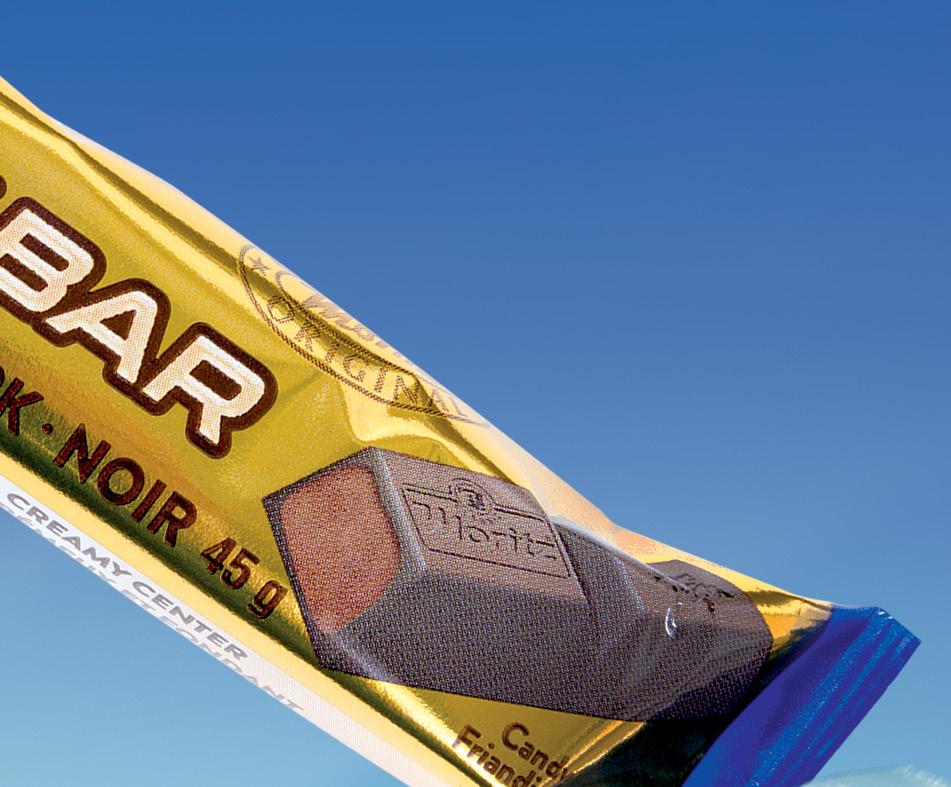


































From coast to coast to coast, companies and individuals are challenging the status quo, with actions big and small that play an important role in effecting change for people and the planet.
Convenience Store News Canada launched the Impact Awards in 2022 to shine a light on these initiatives and share positive stories about how retailers, operators, suppliers, distributors and industry partners go above and beyond in four key areas: supporting employees; sustainability; diversity, equity and inclusion; and community service/giving back. Now in its third year, the CSNC Impact Awards salute those in the industry who are committed to making change and advancing important issues.
BY MICHELE SPONAGLE AND MICHELLE WARREN | ILLUSTRATION
BY
FEDERICA BORDONI






















(1553864 Alberta Ltd.): Calgary
For Petro-Canada, giving back to those who serve as caregivers in communities across the country is a top priority. “Family caregiving can be a challenging role,” says Srinivasa Veeraghanta, area retail licensee. “Many Canadians are unexpectedly called on to provide critical support without any training.” In fact, more than eight million dedicated Canadians invest significant time and energy into providing care for their loved ones. Unfortunately, their efforts and commitment often go unnoticed. The aim of the Petro-Canada CareMaker Foundation is to change the narrative and empower family caregivers. It raised more than $100,000 nationally. Veeraghanta has been a supporter since the foundation began in November 2020. He hosted and participated in the Stride for Caregivers event in 2023, along with staff in the Calgary area. They walked 5,000 kilometres around
the Nolan Hill location to raise awareness. His gas stations were also involved in CareMakers Blitz promotion programs with a portion of the proceeds from sales donated to the foundation. Veeraghanta donated $5,000 himself and vowed “to conduct similar events every year and try to raise more funds to support the family caregivers and make a difference in the lives of family caregivers.”
Across Canada, BG Fuels, a fuel and convenience retailer, operates Waypoint Convenience. It established Waypoint Cares in 2022 and began its inaugural year in market in 2023 to show the brand’s commitment to being a contributing member of the communities in which it operates. Since the inception of Waypoint Convenience, the goal has been to support and engage with its customers and communities. Giving back remains a priority for the company, shown through its partnership with MusiCounts, a Canadian charity that believes music can transform the lives of young people. In 2023, Waypoint Cares donated more than $11,000 to the organization, funded through corporate initiatives and with an online donation platform. Last summer, the MusiCounts team joined the company in Innisfil, Ont., for a fun afternoon at a grand opening where they educated customers about their mission. They drove donations through a “pay by donation” food truck open to all guests who visited that day. The food truck donation drive was repeated at a second event in Thunder Bay with great success. In 2024, plans include expanding efforts with MusiCounts—continuing event donation strategies, its donation drive and a high-profile campaign that launched just as summer began.
For Canco Petroleum, community is everything. The business started in a small community. As such, it values those connections and feels that the local residents, who have opened their hearts and supported the business, are an extension of their own family. Being loyal to them is important so Canco is there whenever communities need it, from charitable donations to supplying goods. In addition, it raised more than $80,000 for the Make-AWish Foundation with its AIR-Serv machines. “We want to create a balanced work environment,” says marketing manager Amanda Aylen Heins. “Having our head office employees present at Canco locations and our location managers engaged in the communities help us continue to understand one another and
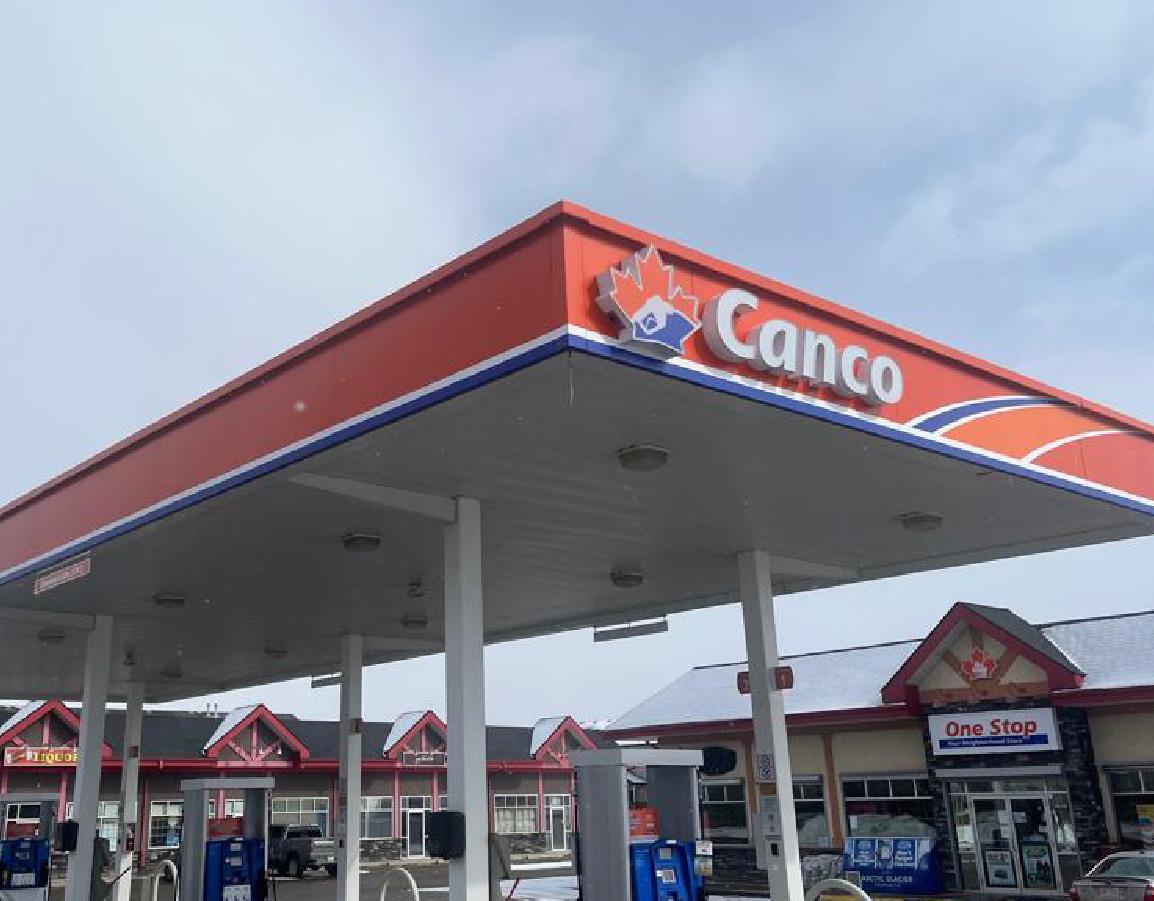
appreciate everyone’s role in building a strong brand and presence.” During wildfire season in the summer of 2023, the head office, local site managers and employees reached out in their communities to see what was needed. Many Canco locations donated food and essentials to anyone in need. “We are a full-circle team and each employee’s contribution plays a substantial role in keeping our adventures going in the Canco business,” she says. “Each aspect would not be functional if it weren’t for our employees.”
In a rural setting, a convenience store, like Carleton Country Outfitters, serves many roles, including a gathering place for the community. Locals talk about the latest news in the community. Tourists stock up on roadtrip supplies and others show up looking for gas or a good cup of coffee. Owner Jennifer Cunningham has gotten to know many of her customers over the years. When help is needed, she’s there to provide a sympathetic ear and anything else to make someone’s day better. Located about 25 minutes from Yarmouth, this business cares about its neighbours. Cunningham puts together Christmas food boxes for families with children and seniors who are struggling. In challenging times, like severe weather or loss of property due to fire, there’s a call for action, which may mean food donations or a clothing drive to help others. She also takes care of ongoing community outreach and organizes services for Remembrance Day, providing both live and recorded versions. Last year, Cunningham took on her largest project to date—the creation of a medical first responder station. Many residents stepped up to receive training from paramedics. Giving back, especially in a rural setting, is the ultimate act of kindness.




















Circle K: Sarah Moncada
Growing up immersed in sports taught marketing manager Sarah Moncada a lot about teamwork and the importance of community. When she joined Circle K in 2020, she wanted to bring those values with her to work every day and couple them with a passion for fostering community engagement. Moncada’s love of marathon running led to Circle K’s sponsorship of the 2023 Toronto Marathon. “Doing something small scale, close to home and relevant to a niche audience can be more meaningful than a big campaign that doesn’t actually touch people or make them feel something, but rather just inundate them with logos and meaningless content,” she says. Since the marathon, she created a process for district managers to enable activation in small, meaningful ways within their communities. “The meaning of community is deep rooted within me and so I plan on keeping that momentum and engagement with operations to continue to bring opportunities for community engagement to the forefront,” she adds. Community engagement drives traffic and return visits, Moncada notes, as well as creating loyalty and brand love. Circle K continues to lead by example, taking part in numerous events over the last year, including Toronto Metropolitan University Hockey Championships and Thunder Bay Winter Games.
ClearWater CarWash: Alberta
“We strive to be a responsible corporate citizen that contributes positively to the local community’s environmental, economic and social well-being,” says Jayson Sevilla, site manager. For ClearWater CarWash, that means a multi-layered approach, which includes sustainability measures, like using 55% reclaimed water and biodegradable soap

for the wash process and encouraging the adoption of electric vehicles by offering Level 2 EV charging stations on-site. It also endeavours to raise awareness about eco-friendly practices and the benefits of professional car washing over home washing, such as water conservation and environmental protection. Being a good corporate citizen is also about being a community champion by supporting local businesses and charities, such as the St. Albert food bank, plus regular participation in local events, like the Rainmaker Parade and seasonal fairs, plus creating jobs for residents. “By integrating these community-focused initiatives into our business model, ClearWater CarWash positions itself as more than just a service provider,” notes Sevilla. “We believe in fostering an inclusive environment for our staff, beyond their professional roles. We create a stronger bond with them by nurturing their personal growth, recognizing their interests, and celebrating their victories. Community events provide the perfect opportunities to demonstrate those commitments.”
As a family-owned Canadian business, Coke Canada values close, local connections with the communities in which it operates and a mission to deliver optimism and create better futures for its employees, customers, consumers, and communities. It’s about making a positive difference in Local Bottler

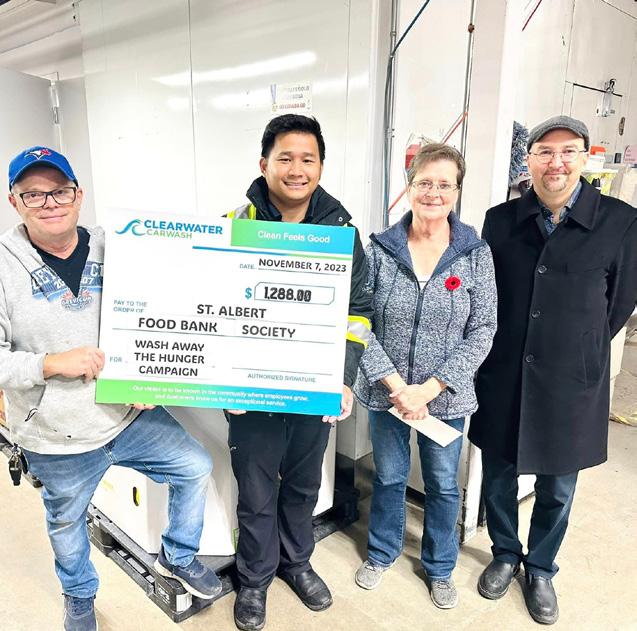

communities across the country through its industry-leading program, Your Local Bottler. Activities are employee-led and planned, designed to maximize hourly and salaried employee engagement, allowing employees to volunteer their time in areas where they feel will make a difference in their local communities. There are employee engagement committees across Coke Canada’s 18 market units. Volunteerism activities are aligned with Coke Canada’s key community pillars—Diversity, Equity and Inclusion, Youth Employability, Environmental Sustainability and Economic Prosperity. With its Local Bottler program, Coke Canada allocated $80,000 to enable 5,900 employee volunteerism efforts coastto-coast in 2023 with 120 volunteer initiatives completed alongside more than 200 community stakeholders. Over 100 employees participated in tree-planting events in British Columbia, Alberta and Quebec through Tree Canada. Coke Canada’s Brampton team participated in a community cleanup, worked with Anishnabeg Outreach Centre, hosted a clothing drive and partnered with the local chapter of Big Brothers and Big Sisters for a career mentorship program.
For Conagra employees, generously giving their time to volunteer for local organizations that are meaningful to them is a year-round effort, highlighted by some special campaigns. In 2024 alone for the annual Month of Service (recently expanded to two months—April and May), they provided more than 100 hours to non-profits in the Greater Toronto Area, including sorting food to supply 8,000 meals to those in need. With United for Change, employees are encouraged to make financial contributions to organizations like United Way. The most recent campaign netted more than $30,000, with the Conagra Brands Foundation adding another $5,000. GTA organi-






Our mis sion to bring health throug h food to as many people as pos sible beg an over 100 years ag o. Acros s our busines s and our brands, health is our nor th star, and the cornerstone of our impact. But we k now that our health impact is dependent on a healthy planet, as well as thriving people & communities. BRINGING
HEALTH THROUGH FOOD TO AS MANY PEOPLE AS POSSIBLE






























zations assisted are a mixed slate, including Seva Food Bank, Women’s Habitat of Etobicoke and Food Banks Mississauga. Conagra employees in other locations contribute, too. Team members in Dresden lend a hand at the local food bank and donate their time to go grocery shopping for items to help unhoused people, while those at the Boisbriand plant in Quebec aid Centraide (United Way) and Moisson Laurentides (Quebec), which offers food assistance for the greater Laurentians region. It’s integral to Conagra Brands for all Canadian facilities to give back and make a difference in their own backyards. Those impactful initiatives will continue.
In recent years, Express Auto Wash has seen how many people in local communities have struggled. As one of its most important pillars, the company commits to giving back. It has turned policy into action with its Grand Splash Fundraisers, recently raising more than $30K for organizations like Family Services of Greater Vancouver, which is dedicated to advocating and supporting vulnerable children and mothers by providing invaluable resources from food to counselling services. Shoppers and associates promoted the event through marketing efforts. On the day of the event, customers stepped up in a big way to support such a worthy cause. Once again, the “give a platinum wash” program was an instant hit and helped boost the total of donated funds. As well, Express helps the local community by hiring new immigrants who may find securing employment challenging. Ayaaz Jamal, president of operations, believes that actions speak louder than words. Since he joined the company seven years ago, he has continued to put community engagement and innovation at the top of his priority list. Taking care of customers and local communities are important parts of his big-picture approach to success.
In 1985, Don Morris founded Gas King in Lethbridge, Alta., knowing that he had to differentiate his company from all others in a fiercely competitive business. He believed he could stand out from his competitors by focusing on giving to local charitable organizations. He passed away in 1992. To honour his commitment to the communities that helped his company become successful, the Don Morris Gas King Memorial Fund was established. It began simply, with coin boxes collecting spare change from customers with
funds going to various charities. Every three months the money is collected and donated to the local community foundations where its sites are in southern Alberta. Aside from donations at checkouts, Gas King has installed AIR-Serv’s Air for Charity tire inflators at numerous locations over the last two years. The company matches all funds donated to the memorial fund. “We were thrilled to keep the founder’s memory alive,” says company president Brent Morris, who is Don’s son. “Everyone who comes to the checkouts sees his smiling face. The fact that our customers open their wallets and continue to donate change in our name says a lot about what we are doing and how we are impacting the communities we serve.”
The organic beverage company may have a small team in Canada, but it’s mighty, dedicated to staying true to Guayaki’s vision to give back to the planet and to make a positive impact in communities where it operates. In 2021, it became a member of Ocean Wise Shoreline Cleanup. Since then, team members and partners retrieved more than 180 kilograms of trash and recycling across nine Canadian shorelines. “It really is a win-win for the community, but also our team,” says Eric Clark, vice-president and general manager. “Human connection is such an important part of everyday life and being able to disconnect from our usual workday, get outside and do something good for our communities, all while engaging with one another and residents. It has a positive impact on the culture of the team.” Choosing to partner with Ocean Wise also provides a sense of belonging towards a larger goal that is bigger than oneself, the team and the orga-
nization. Not only does it positively contribute to local communities, but such initiatives also set an example of how corporations can prioritize environment and sustainability. “Our goal is to leave our communities in a better, healthier and cleaner environment for future generations,” adds Clark.
Founded in 1958, Harnois Énergies has a long history prioritizing the well-being of its surrounding communities. It supports more than 100 causes each year through donations, sponsorships, or other types of support to













organizations or projects in the cultural, sports or social sectors. The company, which serves the markets of Quebec, Nunavut, Labrador, Atlantic Canada and beyond, believes that corporate philanthropy is more important than ever and that an organization steeped in philanthropic values and culture is a living force. It helps build stronger relationships with its employees, customers and the broader community, as well as creating a unique sense of purpose. Being thoughtful and strategic about corporate giving, Harnois Énergies aims to generate maximum impact for both society and business. Giving back helps it unite the community and bridge some social and economic gaps, too. In 2023, the company contributed more than $400,000 in donations and sponsorships, primarily to groups that promote healthy habits in children and young people, keeping with the family values promoted by Harnois Énergies and a focus on future generations. For example, it has partnered with Jeux du Québec Proxi, which promotes and supports young athletes. Other partnerships include Fitspirit, Bleu Blanc Bouge skating rinks and the Montreal Canadiens Children’s Foundation, as part of the well-being/giving focus.
To help combat food insecurity in Canada, the Cadbury Generosity Campaign aims to make a meaningful impact by supporting food banks and providing a way for all Canadians to give back to the worthy cause. The initiative reinforces its brand purpose—represented by the tagline “There’s goodness in everyone”— by translating it into tangible actions with a multi-faceted approach, including in-store
promotions and online initiatives. In stores, Cadbury pledged $100K to food banks and encouraged customers to double the donation by purchasing designated Cadbury products. Additionally, a limited-edition Cadbury Goodness Bar introduced online invited consumers to donate anywhere between $10 and $1,000 with Cadbury matching dollar for dollar funds to be donated to Food Banks Canada. The campaign yielded impressive results, raising $300K for Canadians in need. Team members were engaged through collaborative efforts to execute the campaign, including designing in-store displays and creating promotional materials. Mondelēz Canada employees were invited to volunteer at local food banks. Shoppers were engaged through compelling messaging, inviting them to contribute to a worthy cause simply by purchasing Cadbury products. Moving forward, Cadbury plans to continue its support for food banks with ongoing in-store promotions and future impact initiatives, inspired by the success of the Cadbury Generosity Campaign.
PepsiCo is focused on creating positive change in the neighbourhoods where it operates and where its associates call home. For more than 85 years, it has remained committed to the local communities through initiatives aimed at uplifting those within them. Volunteering is one way to achieve building stronger connections. The PepsiCo Canada Foundation’s main goal is on fundraising and soliciting donations for conducting, promoting and supporting activities, as well as programs and education, that support health and wellness, especially among underprivileged youth.



Since 2004, the PepsiCo Canada Foundation has donated more than $3 million in grants to local and national charities. In 2023, 16 employee-nominated organizations received a grant, resulting in $160,000 Community Impact Grants invested. PepsiCo Canada and the PepsiCo Foundation provided a $100,000 donation to the Canadian Red Cross in the wake of wildfires in British Columbia and the Northwest Territories. Beloved brands also have their own projects. Stacy’s Pita Chips champions women entrepreneurs through Stacy’s Rise Project, which began in 2024. The Miss Vickie’s brand supported MakeA-Wish Canada during the holidays with its All Wishes campaign. PepsiCo Canada’s annual Employee Volunteer Campaign gives employees an opportunity to secure grants for charities they volunteer with, generously donating more than US$380,000 in 2023.
















Family caregivers are unsung heroes. They provide essential care and support without pay to loved ones. In Canada, where immigrants and non-English or non-French speakers make up a significant portion of the population, understanding and supporting the experiences of caregivers of diverse backgrounds is critical. Since its inception three years ago, the Petro-Canada CareMakers Foundation has demonstrated its commitment to addressing the needs of family caregivers. The foundation’s strategic actions ensure that family caregivers are valued and recognized. In response to the lack of data on marginalized family caregivers, it convened thought leaders, including marginalized family caregivers and care partners, to discuss their experiences and document them. Language barriers emerged as a significant issue, affecting 45% of family caregivers. In 2023, the foundation awarded more than $2.3 million in grants to 120-plus charities. Some initiatives being funded include translation of caregiving toolkits into multiple languages, training for LGBTQ+ family caregivers and the development of caregiving resource templates for ethnic communities. Beyond its grant-making efforts, CareMakers launches creative campaigns, such as the recent Lighten the Load, to bring awareness to the public. Suncor/Petro-Canada and its associates continue to be one of the foundation’s biggest champions and supporters.
When an employee mentioned she was collecting non-perishable food items to help Sainte-Gertrude elementary school in Montreal, SIR Solutions jumped at the chance to participate. That was in 2012. Today, the company continues its Christmas basket initiative. It has evolved and expanded over the years, explains Nicola Hill, director of marketing. “We want to help and do our part.” It’s a multi-faceted approach that includes placing large boxes throughout the office, on-site bake sales with treats baked by colleagues. Fundraising initiatives may also involve a sell your salad contest, which has employees bringing their most delicious creations and staff voting on their favourite. Over the years, there has also been an ugly sweater day, hot cider sale and a wear-yourjeans day, where you could wear denim to work in exchange for a $2 donation. Everyone from management to the company social committee has been involved with fundraising and the donation of clothes, toys and household items. “There has been so much generosity,” says Hill. “And so many emotional moments when we






receive responses to our requests.” SIR Solutions also supports other community efforts, serving meals at the Mission Old Brewery and helping to redesign a schoolyard in the Saint-Michel neighbourhood.
Central to Ben & Jerry’s mission is the belief that all three parts of its mission (product, social and economic) must thrive equally in a manner that commands deep respect for individuals inside and outside the company and supports the communities of which they are a part. One such community is Grassy Narrows First Nation in northern Ontario. Ben & Jerry’s has been supporting Grassy Narrows’ campaigns to stop unwanted mining and logging on their territory, and to hold the provincial government responsible for the
long-term impact of mercury waste dumping, which occurred in the 1960s. This has meant supporting the community with online rallies, in-person rallies, community dinners and events, canvassing and gathering petitions and digital promotion. In summer 2022, the company set up ice cream trucks around Toronto, using ice cream as an opportunity to talk to people about the Grassy Narrows and gather signatures for their petition to the government. As well, the company featured the Indigenous community on its Into the Mix podcast, giving people an opportunity to share their story with an international audience. Since Ben & Jerry’s began working with the community, several mining companies have withdrawn their mining permits and committed to not mining on Grassy Narrows traditional territory.

































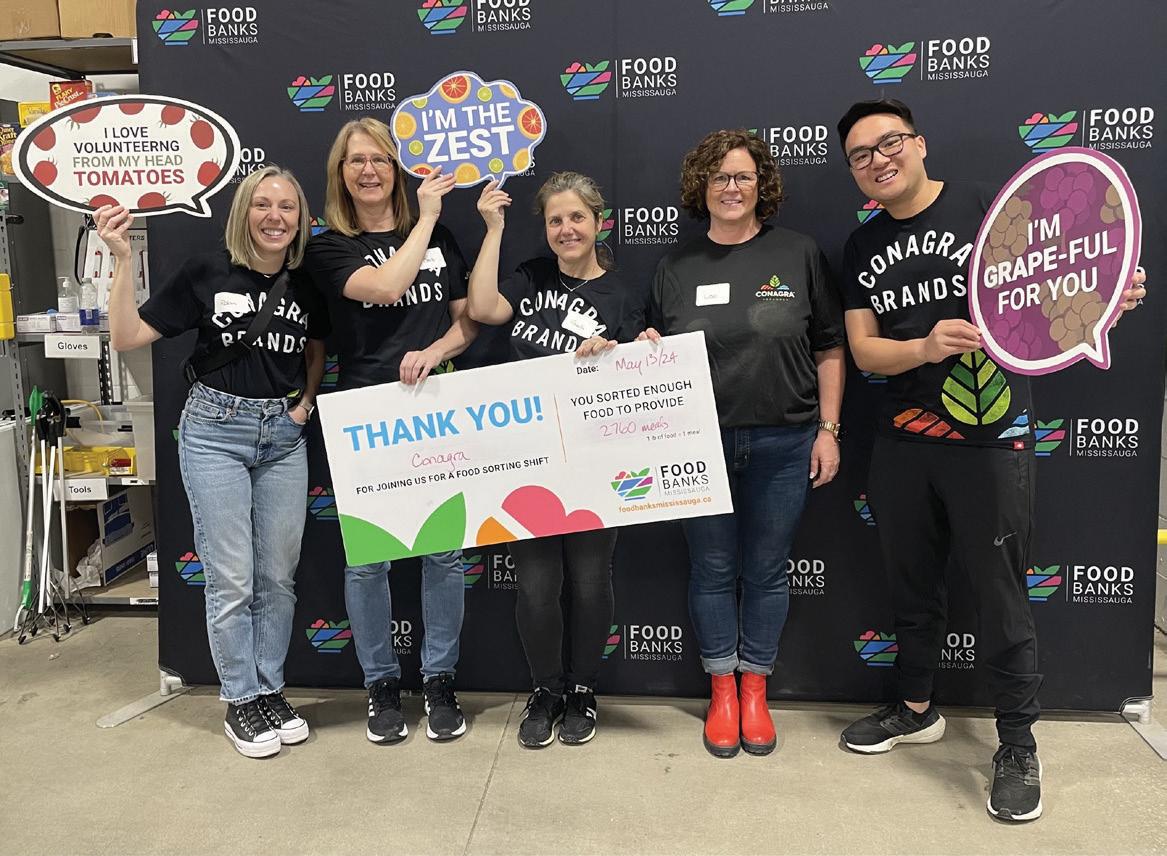



















Adapt Media began in 1988 with investment by Canada’s Indigenous peoples. The company’s first national advertiser 26 years ago was APTN, the Aboriginal People’s Television Network. Today, Adapt works closely with the Canadian government in serving Indigenous communities. To build on this, Adapt founder and CEO, Jamie Thompson, wanted to create a tangible gift to give back. This inspired the launch of iDREAM (Inclusive Diverse Racial Equity Award in Media), a non-profit charity created in 2023 to celebrate and showcase Indigenous, BIPOC and racialized artists. The iDREAM team works with winners to organize high-profile media campaigns—the value of which range from $250,000 to more than $1 million—to help artists gain national acclaim. The hope is to help rewrite the bleak statistic that Indigenous artists in Canada earn just 68% of what white counterparts make. As part of this, the iDREAM campaign uses hundreds of Adapt’s digital screens in convenience stores to act as an eye-catching gallery to showcase work, delighting store associates and store shoppers. iDREAM is led by a board of directors comprised of 15 members, mainly BIPOC people, who come from a range of inspiring backgrounds in media, art and music. Moving forward, iDREAM represents an evergreen opportunity to support and celebrate Indigenous and BIPOC people across Canada.
By becoming a Legacy Spaces partner in fall 2023, Danone joined the Downie & Wenjack Fund (DWF) on the collective journey toward reconciliation in Canada. This partnership was announced during the company’s global Diversity, Equity & Inclusivity Week and DWF’s Secret Path Week, a national movement commemorating the legacies of Chanie Wenjack and Gord Downie. This initiative represents the company’s commitment to ReconciliACTIONS, i.e., a meaningful action that moves reconciliation forward. Through its Legacy Space, Danone’s aim is to bring Indigenous and non-Indigenous people together in the spirit of reconciliation to create awareness, share and learn. The aim is to be a catalyst for important conversations and meaningful change. Reconciliation for Danone in Canada is not just an Indigenous issue—it’s one that is all-encompassing for employees, clients and communities. The company feels it has a duty to ensure it maintains an equitable workplace for Indigenous people. Danone Canada committed $25,000 over the five-year term of the partnership and designated its Toronto office’s main room as a Legacy Space—a safe, welcoming place where conversations and education about Indigenous history are encouraged. It allows employees to continue learning more about the rich and diverse cultures, experiences and histories of Indigenous Peoples.
At Molson Coors, the belief is that everyone has a role in making diversity, equity, and inclusion part of the company’s ethos. To support this in a meaningful way and embrace the company’s evolving customer and employee base, Molson Coors introduced the Empathy Experience.

The two-hour in-person facilitated interactive, immersive and emotionally engaging session for employees, is designed to honour diversity, while building understanding, awareness and empathy. In late 2021, Molson Coors partnered with Sklar Wilton, a strategy and insights consulting firm located in Toronto, to create and deliver a special program that more aptly reflected Canada. After months of planning and facilitator recruiting and training, in June 2023 the team opened Canada’s first Empathy Experience in Toronto. At the same time, it rolled out Expanding Empathy, which served as a standalone program for employees in other cities, as well as an expanded discussion tool to dive deeper into concepts and spur deep discussion—it’s since been delivered to more than 200 employees. The evolution of the Empathy Experience continues in 2024, rolling out to brewery locations in British Columbia and Quebec. As well, the team continues to expand the reach of Expanding Empathy, adjusting the content to meet the specific needs of teams across the organization and providing the tools and resources needed to have brave discussions that spur change.
For three years, Muskoka Brewery has been a Gold Level certificate holder for Gender Parity with the Women in Governance organization. The brewery strives to be an organization where people of all genders have the chance to succeed, rise in the ranks and to lead the way within the company and the industry, as an example of gender equity in action. This designation and the brewery’s ongoing efforts matter to the organization and the communities it serves as a way of demonstrating that everyone is welcomed, valued and involved. The designation requires a strategy of governance and vision to show that its policies, practices, decision-making and more are equitable, resulting in progressive representation of women and men. The company also needed to show it acted upon what it believed and show results for steps taken, namely progression towards equity or parity in the distribution of women to men in terms of promotion, recruitment and compensation. “Our future connection to living our beliefs (is) to continue to demonstrate that, as an employer, Muskoka Brewery remains committed to ensuring that gender parity plays a role in all staffing decisions and that equitability is found, demonstrated and lived in all departments,” explains Gavin Whitehead, channel manager—grocery, export & emerging retail channel.
Nestlé Canada believes that Diversity, Equity, and Inclusion values are vital to creating a culture of success that respects diversity, pursues equity, enables inclusion and ensures its workforce reflects the consumers and communities it serves. To ensure its DE&I efforts are comprehensive and impactful, the company established two unique streams of DE&I groups: Employee Resource Groups (ERG) and DE&I Functional Groups, made up of more than 150 employees. While each group has its own unique mission, they work together to create a work environment where every employee in Canada feels they belong. ERG groups support the creation of policies, guidelines, resources and programs for Nestlé Canada’s 3,500-plus employees, focused on accessibility, mental health, the 2SLGBTQI+ community, gender balance and race and ethnic inclusion. DE&I Functional Groups are made up of employees that represent their own functions within Nestlé Canada and ensure that DE&I is embedded in everything, from operations to strategies and decision-making processes. This approach has been successful. Nestlé Canada is a world leader amongst other markets for diversity in the workforce, specifically with gender balance. The company’s global progress has been recognized in the Bloomberg Gender Equality Index.
DEI initiatives aren’t just a part of PepsiCo’s long-term success; the company considers them to be competitive advantages. As such, it recognizes that these efforts are the right thing to do for its business, employees and communities it serves. That has led to a comprehensive strategy and philosophies


represented by initiatives like PepsiCo Positive (pep+), which drive action and build a more sustainable future. Diversity programs are vast, from the She is PepsiCo Employee Spotlight campaign designed to make talent pools even more inclusive, to the Everyday Inclusion Workshop instructor-led training to help adopt inclusive behaviours, and Racial Equality Journey aimed at investing in Black employees and communities. Health and wellness programs provide a range of support for employees’ total wellbeing—physical, mental and financial health. An extensive benefits package allows employees to customize their benefits to suit their needs. In 2023, new added member benefits include coverage for gender affirmation and fertility drugs, plus expanded coverage of mental healthcare, coupled with resources and training for those in leader-
ship roles to promote resilience and combat stigma. Programs are designed to be as flexible as possible, with perks like four wellness days and a paid sabbatical leave program of up to six months for employees.
SRP is committed to embedding the core values of diversity, equity and inclusion in every aspect of operations. Achieving that means leading by example: 57% of the company’s leadership roles are held by women, showcasing the company’s dedication to gender diversity. Each leader comes from a different ethnicity and its workforce is made up of more than 10 different ethnic backgrounds. “DEI is core to our team, ensuring top talent is onboarded and nurtured,” says president Shuvanan Islam, SRP Companies Canada.


“It has a global perspective and breadth of experience, which is crucial to winning.” Creating a workplace where everyone feels safe, valued and connected is key so employees can thrive and reach their fullest potential. Each summer, the team gathers for company-wide barbecue parties to enhance bonding in a relaxed setting, ideal for employees to unwind and connect. SRP also fosters a culture of appreciation and camaraderie through a weekly tradition of providing free breakfast every Friday. The Awardco employee recognition program celebrates outstanding contributions, ensuring every voice is heard. “SRP is committed to fostering an environment where employees feel genuinely valued and empowered to achieve their full potential,” adds Cathy Senderovich, senior operations manager.
For CEO, founder and owner Roxanne Joyal, empowering women is a top priority for her company. “Our mission is to enable companies to uplift and empower women coffee farmers and their communities in countries along the coffee belt through their choice of coffee,” she says. This focus is supported by a key fact: In the developing world, for every dollar a woman earns 90 cents goes to her family and community—a powerful multiplier effect that accelerates positive outcomes. Another important fact: 54% of small businesses in Africa are owned by women. When &BACK buys coffee from women farmers in Kenya, for example, it sends a ripple effect of positive impact, which helps strengthen entire communities. The company also supports financial literacy training for women there
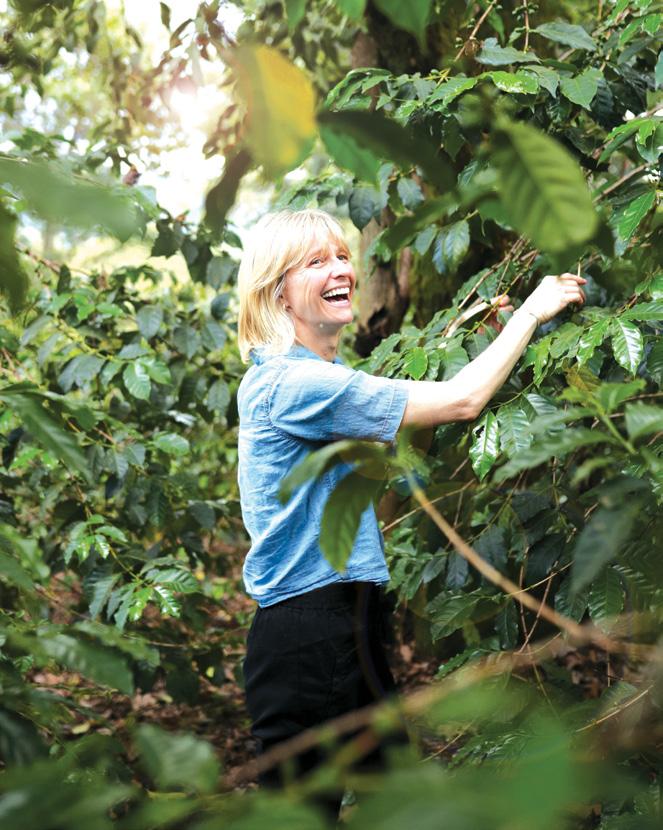
and reinvests in women coffee farmers by providing the tools, support and resources to help them manage their finances. Meanwhile, in Ecuador, &BACK offers agricultural training aimed at improving farming practices, crop yields and sustainable practices. These efforts are key to &BACK’s dedication to enabling companies to uplift and empower women coffee growers and their communities through their choice of coffee. Or as the company says, “There’s taste and purpose in every cup”—a core principle for more than 25 years.
It’s no easy feat for a company to relocate their office without major disruptions for employees, but Conagra Brands managed to do it seamlessly by ensuring everyone was well informed about the move through a new office committee. In March 2024, the company welcomed staff to its new digs, located minutes away from Toronto Pearson Airport. Employees were welcomed into a bright, modern space with areas for collaboration, state-of-the-art technology and privacy pods for making calls. They also had ergonomic chairs and sit-to-stand desks available at each workstation. Before staff arrived, every effort was made to keep them up to date about the move through meetings, an ambassadors’ program to address questions and a comprehensive guide to the new office with details on everything from parking to the cafeteria. Activities launched in the first week in the new office helped create an inviting atmosphere, including a catered hot lunch for employees and a welcome breakfast. The Canadian leadership team gifted each employee a swag bag with items like branded tumblers and new keyboards. The initiatives were well worth it. Feedback from employees was overwhelmingly positive. Looking ahead, the company is exploring ways to share the office space with their families and kids.
Since Nestlé Canada launched its Changemakers employee brand campaign in 2023, the word ‘changemaker’ has become a meaningful term company-wide. A changemaker is someone who makes a difference in big ways and small ones. They challenge the status quo and are passionate about making


things more efficient and more impactful. To kick-off the program, the executive team nominated seven employees, representing varying levels of experience and seniority. The company created a video to showcase the nominees and explained how each reflected Nestlé’s culture and values. It also launched an internal recognition program, Changemakers of the Month, where employees can nominate their peers—to date more than 150 people have been nominated. CEO John Carmichael announces the winners during his monthly CEO webcast. Each receives a personalized letter from the CEO, significant recognition points as part of the Real Recognition program and a prize pack. Nestlé Canada’s 3,500-plus employees supported causes, such as Kids Help Phone’s Walk So Kids Can Talk and Food Banks Canada’s After the Bell program. Nestlé Changemakers program has had a significant impact and is a driving force within the organization. In an internal survey, 86% of employees said they believe Nestlé is a great place to work.
Propel prides itself in having laid a strong foundation for outstanding employee experiences and culture since the 2002 inception of the company, which has now grown to a team of more than 50 people. “In creating the culture, we have allowed for open communication, mutual respect, shared goals, and commitment to growth and development. It makes us a stronger company,” says company president Patrick Higgins.

In addition to milestone and birthday celebrations, as well as team lunch, an annual baseball game, pre/post trade show celebrations and employee appreciation days, the GTA business supports its people giving back. Employees join forces as a team to volunteer with Community Food Centres Canada and working in kitchens to prepare meals for people in need. They have also worked with food banks throughout Ontario, CP24 CHUM Christmas Wish, selecting and preparing gifts





















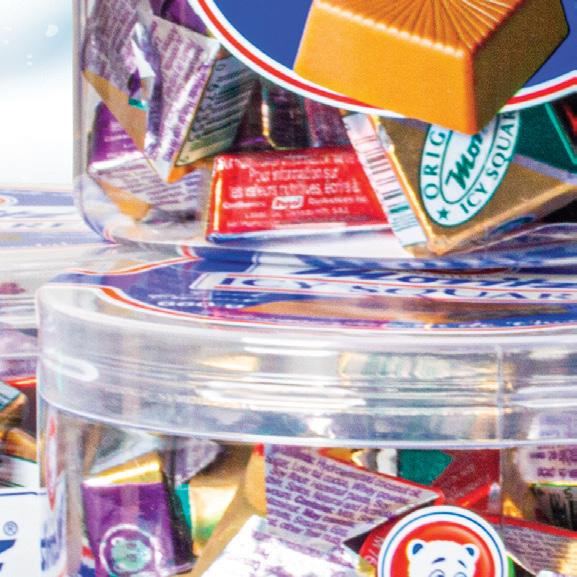




















































































for children, wrapping presents and taking part in events to raise funds for cancer-related charities. The prioritization of employees by Propel has earned the company certification as a Great Place to Work in Canada. It’s proof that the company supports its team members, who fill out and submit a detailed survey to gather feedback for the award.
The data about food waste is alarming. A staggering 40% of the world’s food goes to waste, responsible for 10% of greenhouse gas emissions, according to Too Good to Go (TGTG), a social impact company working to combat food waste. In January 2023, 7-Eleven Canada partnered with TGTG to leverage its mobile app by offering customers affordable surprise bags of their favourite foods for one-third of retail value. The TGTG app connects customers with unsold food from 7-Eleven. Items (from donuts to fruit salad) nearing their best-before dates go into a surprise bag and are made available for purchase and pick up through the app. The collaboration between 7-Eleven Canada and TGTG was created to inspire and empower its team to fight food waste. Initially, 37 stores in British Columbia and Ontario piloted the program with two surprise bag options.
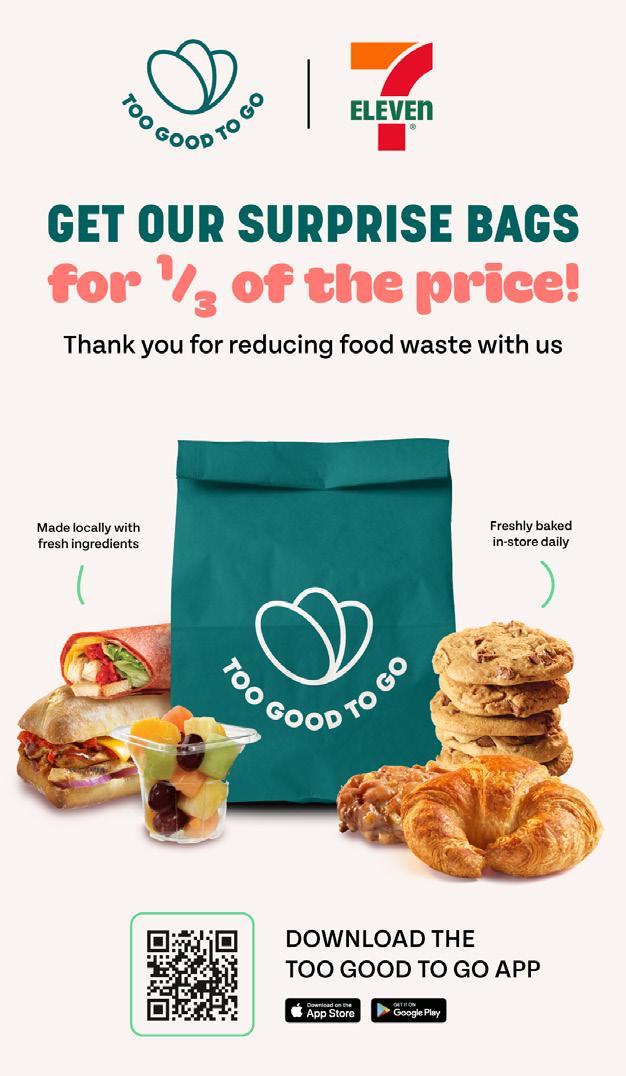
Since then, TGTG has rolled out to more 495 7-Eleven stores across Canada. From January 2023 to May 15, 2024, 7-Eleven Canada’s TGTG program saved over 197,000 meals and helped avoid in excess of 1.16 million pounds of CO2 emissions. Meanwhile, 80% of customers said they’d buy a surprise bag again.
BIC’s popular EZ Reach lighter, launched in December 2020, with sustainability as a key consideration. It uses four times less plastic per flame, has a 66% reduction of CO2 per flame, and a 30% reduction of packaging. The product was recognized with the General Merchandise Gold Award at the 2021 Convenience Innovation Awards. The win also highlights the importance of the convenience channel for the EZ Reach lighter and the innovative nature of this new product. And there’s more to BIC’s big-picture successes. About 80% of its employees work in 14 factories that are ISO 14001 certified or about to be certified. In those facilities, 76% of the electricity used is of renewable origin, reflecting a commitment to reducing environmental impact. Between 2021 and 2022, BIC achieved a 19% reduction in water consumption per ton of production. As well, 79% of all BIC lighters are sold without consumer packaging, which helps significantly reduce waste. Looking ahead, BIC is committed to focusing on consumer needs and sustainability. It will take further actions to reduce its environmental footprint and develop new products that align with the company’s sustainability goals.


As part of the company’s global commitment to Building a Smokeless World and Better Tomorrow initiatives, BAT/Imperial Tobacco Canada continues to take strides toward a more sustainable vape brand. Current estimates show that 29 million batteries came into the Canadian market in 2023—the result of growth in the disposables segment. Vuse GO, an updated range of modern disposable vaping devices, was developed with sustainability at the forefront. “Knowing how many single-use batteries are introduced in the market every year, it was important to us to give consumers a simpler option to dispose of their batteries in a more sustainable way. We’re proud to have designed our new Vuse GO devices with removable batteries, allowing them to be safely and responsibly disposed of at the end of their life cycle,” says Emily Bexon, head of the vapour category in Canada. The Vuse Take Back program ensures used vaping devices and pods are properly segregated and recycled and/or responsibly disposed of. Since the program’s launch in 2019, more than 1 million pods and devices have been prevented from ending up in landfills. “We are steadfast in our resolve to pioneer sustainable practices, ensuring that every vaping experience we offer empowers consumers to enjoy their products responsibly,” she notes.
Coke Canada’s sustainability action plan, Toward a Better Future, Together, began in 2023 and came out of consultations with internal and external stakeholders. Actions taken include the 100% rPET product launch, making Coke Canada the first bottler to launch sparkling beverages in 100% rPET in the country. The measure helps reduce the use of virgin plastic and lower the company’s carbon footprint compared to other types of packaging. Coke Canada has reached a 97% waste diversion rate for its manufacturing facilities and maintained an average of 70% recycled content in aluminum packaging. Another







important measure of its sustainability action plan has been greening its fleet with electric trucks and biofuels. It became the first CocaCola bottler in North America to pilot the use of zero-tailpipe emission trucks, thanks to a new partnership with Volvo in the Greater Montreal Area in 2023. Using water more efficiently is also a key goal moving forward. For example, the Weston plant reduced water use by 62 million kilolitres—equivalent to nearly 25 Olympic swimming pools. There’s more work to be done and Coke Canada is dedicated to doing it as part of its belief that business and environmental sustainability go hand-in-hand.
Gas station islands deteriorate over time, leaving them unattractive and in disrepair. Refurbishing them has been a costly, time-consuming proposition—one that required bringing in heavy equipment to tear up the existing gas station island. Also, it would take four to six weeks and retailers would lose revenue, as pumps were shut down during reconstruction. This method also generates a large amount of concrete debris to be dumped into landfills at a significant expense. Four years ago, Countryside Concrete Services came up with a less-costly alternative option to make fuel islands look brand new again. CEO Marco D’Alfonso and his cousin Augusto, who serves as president, created System 28 Wrap, a patented, modular system that uses stainless steel bands to wrap around the perimeter of the island. To finish, the upper surfaces are painted with a long-lasting, non-slip topcoat. It dramatically reduces waste and permits gas stations to remain open while the fuel islands are transformed. There’s no welding or hot work involved, making it a safer process. “It’s basically a makeover for gas station islands,” explains Marco. “It has less impact on the envi ronment, less impact on customers, clients and retail operations from a cost perspective. It’s a better solution for all.”

the most impact—reducing methane. It’s the first food and agriculture company to set such a target. Danone has set 12 sustainability priorities and 35 impact KPIs. Its focus includes curbing GHG emissions, supporting regenerative agriculture, preserving and restoring watersheds where it operates and driving water footprint reduction. Sustainability and related discussions are a part of every Canadian town hall and ongoing employee engagement surveys are used to evaluate opinions about Danone’s ongoing efforts to uphold its commitments. In a changing world, it promises to stay focused on its sustainability goals and adapt.
Before Photos
In 2016, the Quebec-based food distribution company began its La Cour aux Saveurs program, focused on fresh, high-quality ingredients. At the beginning, the concept was for convenience stores with kitchens to cook chef-created recipes in-store. In 2023, the company created a central kitchen to serve all its customers, especially those who don’t have the space or labour to offer foodservice to their customers. The program was launched largely because of the high consumer demand for fresh, healthy food, even when they are in a rush. Careful attention is paid to minimizing food waste and offering sustainable packaging. Sustainability matters. “As a company, we have to lead by example,” says Serge Nadeau, vice-president projects & devel-
opments. “Today, the planet and the environment need to be a part of all of our strategies.” In addition, as part of its giving back efforts, Groupe Beaudry, which is the largest independent food distributor in Eastern Canada, is a proud supporter of the Breakfast Club of Canada, which serves more than a quarter of a million nutritious breakfasts daily in almost 2000 schools nation-wide. The company’s clients and customers help make a difference through this important program.
Stainless steel band install
7-Eleven Store 35758, Flower Mound, TX
Bringing health through food began for Danone more than over 100 years ago. Over the years, that mission has evolved. In 2023, the company launched the Danone Impact Journey, a multifaceted program outlining ways to make a positive impact through its brands for farmers and their communities, as well as consumers and their families. As the largest consumer-facing B Corp-certified company in Canada, Danone has become a leader for creating change. Its goal is to decarbonize its business and lead where it can have

A common thread runs through everything KIND makes and that’s the desire to create a kinder, healthier world. In practice, it takes various forms, including a commitment to sourcing 100% of its almonds from bee-friendly farmland that leverages regenerative agriculture practices on a mass-balance basis by 2030. KIND became the first snack company to make such a commitment, announcing the goal in 2022. The KIND Almond Acres Initiative is the first step and will help KIND inform how it engages with suppliers as they transition to more sustainable practices. The company is also tracking five environmental outcomes to learn how it can grow almonds more sustainably. The findings will help it set environmental targets and reach its 2030 goal. As senior key account manager Samuel Tenenbaum notes: “We are putting our money where our mouth is by co-creating this pilot with our supplier, ofi, to trial these practices and measure their outcomes.” Last year, KIND worked with Pollinator Partnership to become one of the first brands to pilot a third-party verification for Bee Friendly Farming certification. The company is also testing and experimenting with alternative packaging and advocating for better recycling, while continuing to focus on reducing greenhouse gas emissions.

Muskoka Brewery
“It is important to us to be a leader in environmental stewardship. Being based in the Muskoka region of Ontario we are fortunate to be surrounded by a wide and diverse environment,” says Gavin Whitehead, channel manager—grocery, export & emerging retail channel. “With the Muskoka Brewery Community Fund, it’s our promise to make a difference in our community and a commitment to preserving our natural environment.” In keeping with its goal, the brewery has partnered with Veritree, a B.C.-based organization aiming to embed nature into more than 100,000 businesses) to make an impact in restoring the planet. Participation in this program was taken to step up the company’s positive contributions to the local environment. “As a beverage producer our industry uses natural resources in our production process,” says Whitehead. “Though we follow strict guidelines to help reduce our footprint, this was one more active way to involve ourselves in the environmental improvement opportunities allowed to us.” The company also strives to take proactive steps above and beyond its current work to manage its carbon footprint. As a result, 2,500 trees were planted in summer 2024. Muskoka Brewery shares information about its environmental initiatives on-site at the brewery and online.
Nestlé’s size and scale are key advantages in helping to transform the global food system. That has meant tapping into its network of employees, farmers, retail customers, partners and consumers to create change through its brands. The Nestlé Cocoa Plan aims to build a more sustainable supply chain for cocoa by working with farmers, communities and local and international organizations to develop solutions to meet the challenges facing cocoa-farming communities. This plan now reaches more than 179,000 farmers, building on our three pillars: better farming, aiming to improve livelihoods in communities; better lives, aiming to improve social conditions for families; and better cocoa to improve sustainability. Nestlé is on track to source 100% of its cocoa through the Nestlé Cocoa Plan by 2025. It’s an issue Canadian shoppers care about. In 2023, Nestlé commissioned a survey that found 73% of participants agree they want to support farmers and communities in developing countries. Building on the Nestlé Cocoa Plan, the Income Accelerator Program aims to help reduce child labour risks and increase incomes for cocoa-farming families. It supports school enrollment, good
agricultural practices, agroforestry activities and diversified incomes, and women empowerment. The program continues to progress, reaching about 160,000 cocoa-farming families in the company’s supply chain by 2030.
PepsiCo Positive (pep+) is the company’s roadmap for promoting positive change for the planet and people. It aims to fundamentally transform business as usual within its corporate sector by inspiring and working alongside peers to advance positive social, environmental and economic change for all. The pep+ initiative has three pillars: Positive Agriculture, which focuses on sourcing crops and ingredients in ways that restore the Earth, like using sustainable sourced Canadian potatoes for its potato chips; Positive Value Chain, the building of a circular and inclusive value chain; and Positive Choices, aimed to inspire everyone to make healthy decisions. Currently, more than 70 green initiatives are underway across PepsiCo Beverages Canada facilities. The company believes operating more sustainably is essential to how it does business. For instance, PepsiCo Canada achieved its 100% renewable electricity target in 2023. And by the end of 2024, it aims to eliminate virgin plastic bottles from its single serve carbonated soft drinks and water portfolio by offering more brands in 100% rPET bottles. Carbon emissions are also reduced by approximately 30% for every 100% rPET bottle. In addition, PepsiCo says it is the first beverage company to commit to a North American roll out of paper-based solutions to replace plastic rings for multipacks.
Sustainability and the environment are subjects that Rabba Fine Foods keeps top of mind. Recognizing that food waste is an urgent environmental issue, it is building on its long-standing partnership with the Mississauga Food Bank to minimize food waste. The


company recently introduced a weekly food rescue at retail program where select locations are working with the Mississauga Food Bank to offer fresh in-store products, which is a better alternative to food going into landfills. Rabba also entered into an agreement with Green Integrations and Star Energy Solutions to develop solar generation to help reduce the carbon footprint of its grocery network. The project, which was completed at the end of 2023 and landed the company an Impact Award last year, generated more than 1.5 million kWh of electricity annually, thereby offsetting the majority of electricity requirements for Rabba’s Mississauga distribution facilities. It involved the installation of more than 2,500 solar panels, resulting in a drastic reduction on the electricity grid. This initiative will further offset 992 metric tons of CO², akin to eliminating an additional 225 cars from roadways. Recently, Rabba joined forces with Second Harvest to provide convenient access to grocery essentials for those in need and to rescue approximately 25,000 pounds of food annually, providing convenient support to local charitable organizations in the GTA.
Being mindful of packaging choices is at the forefront for many companies, including SRP. It is an area of growing concern as the accumulation of packaging waste increases in landfills. SRP is taking active steps to reduce packaging sizes and switch to FSC-approved materials, including for its private brand electronics program, CT Tek, for Circle K/Alimentation Couche-Tard. The company’s design and engineering teams have worked on optimizing size and shape to create right-size packaging with minimal material usage to reduce waste. Choosing eco-friendly materials, including recycled and recyclable options, is another way to help eliminate excess plastics. The bonus is that the measure has resulted in cost savings, from less funds spent on raw materials to reducing storage and transportation expenses. Developing packaging solutions is a collaborative effort that goes beyond internal departments and associates to suppliers, retail partners and customers. The commitment to the environment is important to SRP. It aligns with its corporate social responsibility goals and shows that the company is a responsible, forward-thinking partner. Looking ahead, efforts will continue to find new ways to reduce packaging waste and extend its impact further by leveraging partnerships. The goal is to drive positive change across the supply chain and promote sustainability throughout the industry.


The monthly New on Shelf e-newsletter features products carefully selected by our editors, as well as sponsored product placement.
From confection to snacks, beverages and more, we’re spotlighting product innovation.
Sponsored products will:
• be featured in our New on Shelf enewsletter – you choose the date
• live on ccentral.ca- so retailers have access 24/7
• be promoted through brand social channels
Specifications
• 1 product shot (655 x 368, 1MB, JPG file)
• 1 product write-up (50-75 words)
• Click-through URL featuring the product

Contact your sales consultant to spotlight your product!
BY MICHELLE WARREN
THE PANDEMIC DRAMATICALLY accelerated consumers’ and c-stores’ adoption of new retail technology. Now we are seeing a stabilization, as people settle into routines.
For instance, as consumers return to busy schedules, from work to social activities and travel, use of self checkout at register and drive-thru have notably increased vs. last year, according to the 2024 C-store IQ National Shopper Study. Working with the research team at EnsembleIQ, Convenience Store News Canada surveyed more than 2,000 convenience shoppers across the country to examine their wants and needs at retail, specifically convenience and gas.
In turn, use of some of those technology-enabled services popular during lockdowns, such as ordering online with pickup curbside, continue to wane overall, but particularly at convenience.
That said, c-gas shoppers are ahead of the curve when using several tech-enabled services at convenience, including the use
Shoppers that have experienced solution at any channel
Self check-out at register Drive-thru Home delivery
Mobile coupon/discount
Order online, pickup in store
Mobile pay at pump
Mobile payment app
Order online, pickup curbside
Self check-out with retailer’s app
Contactless using AI sensors
Have not tried any of these
Satisfaction using solution at convenience store
of mobile payment apps, self checkout with retailers’ apps and contactless payment using AI sensors.
Overall, mobile payment apps and self checkout at register rate the highest satisfaction when experienced at c-gas operations.
Shopper preference for most tech-based solutions maintain similar rankings compared to 2023, however drive-thru and mobile coupon/discount have gained in popularity.
Conversely, not all shoppers are embracing technology, with over half (52%) saying they prefer a traditional staff-supported experience for checkout, a slight uptake on the 50% last year.
We know shoppers’ comfort with, and use of tech-enabled retail solutions has increased dramatically since 2020. Now, it’s up to retailers to employ these technologies to truly enhance the c-gas customer experience through services and offers that make life easier and more affordable.
Shoppers that have experienced solution at c-store
Mobile pay at pump
Mobile payment app (e.g., Apple Pay)
Contactless using AI sensors
Mobile coupon/discount
Self check-out with retailer’s app
Self check-out at register
Home delivery
Drive-thru
Order online, pickup in store
Order online, pickup curbside


























































































BY MICHELE SPONAGLE

As alcohol sales begin in Ontario c-stores, how can you take advantage of the strength of the ready-to-drink cocktail category? Tap into the trends
INTRODUCING ALCOHOL SALES to convenience stores this fall comes at an interesting time. Consumption trends in Canada are in flux, but one category stands out as a ray of sunshine—ready-to-drink (RTD) and spirit-based coolers. In its 2022-23 annual report, the LCBO said that they have been one of the fastest growing and most popular categories in recent years. In 2023 alone, RTD sales climbed by 6.8%. Statista is showing that RTDs have soared by 180% since 2010.
For c-stores, it’s a category that shouldn’t be
overlooked. But with limited shelf space available, the burning issue is what RTDs to stock. It would be wise to pay attention to trends and experts in the space.
Meet the need for convenience
Toronto-based cocktail expert Christine Sismondo has thoughts. “During the pandemic, many people took up home bartending, but now they’ve pulled back. They don’t want to be buying all the liquors, specialty glassware and tools necessary,” she says. “The
focus now is having a tasty drink and getting it quickly, whether you’re entertaining in your backyard, camping or at a cottage. RTDs meet that need for convenience.”
When curating a selection of RTDs in-store, keep in mind versions with low or no sugar and alcohol. Canadian consumers, especially younger adults, are seeking healthier options. And even those not drinking them want to have RTDs available for guests.
In the world of flavours, exotic is where it’s at, says Sismondo. Think tropical fruit, like coconut, mango and passion fruit. Nostalgia is also at the forefront, with some makers tapping into flavours inspired by Creamsicles, for example. She points to the ranch water trend as one with momentum, noting the combination of tequila and soda is here to stay.
Her advice for c-stores is to mix it up with their RTD selection. “It’s not like beer or the old school liquor approach where consumers always reach for the same thing,” she says. “They want to try something new. People get excited when they see a product they haven’t tried before, so stock a wide selection of RTDs.”
For one Ontario craft distiller, the hope is that its sole RTD, a premium, pre-mixed gin and tonic, will find a spot in c-stores. Graham Reid, co-owner of Reid’s Distillery in Toronto, is optimistic the convenience channel will lean in on the local craft producer trend. “So far, it has been very challenging,” he says. “As a small, family-run business, we’ve had trouble connecting with convenience store owners and buyers. We know our RTD would perform well if we can get onto the shelves.”
Big players with deeper pockets have the advantage. Reid says he has a preliminary conversation with one c-store chain and learned the cost of getting one SKU listed across Ontario locations was $250,000. “That’s the roadblock we’re facing right now,” he says. “But we’re optimistic there will be a desire to support local players, too.”
He’s also feeling positive about two additional products he’s planning on bringing to market once buyers are lined up. Seizing on the health mindset of consumers, Reid is looking at a zero-sugar version of a classic gin and tonic, made with 1642 Tonic Zero from Montreal, formulated with Stevia, plus a regular elderflower G&T.
For Molson Coors Canada, ensuring that RTDs are successful in their new retail environments is a priority, according to Leslie Malcolm, the company’s vice-president of marketing. “The most immediate task is to build consumer awareness and facilitate the adoption of RTDs and beer now available in grocery and convenience stores,” she says. “Since this represents a new purchasing

channel for these products, it requires a shift in consumer behaviour and a relearning of buying preferences.”
Molson Coors hopes to build on the success of their current RTD brands, including Simply Spiked, Coors Seltzer and Vizzy. There have been dynamic shifts toward options lower in sugar and calories, including hard seltzers, which now make up 36.6% of total RTD sales. There’s also a noticeable swing towards full-flavour offerings, showing an 8% increase. This category includes coolers and hard teas. “Simultaneously, there’s a rising preference for regular to high ABV products, with favourites like hard seltzers, such as our own Vizzy Max at 7% ABV,” Malcolm adds.
The company is also experiencing success because of that nostalgic-flavours trend. Sales of its Slushie-inspired Coors Seltzer have surged by more than 30% in the past year. Both Coors Seltzer Slushie and Arizona Hard Tea capitalize on consumers’ love of the past and the memories it stirs. Molson Coors is committed to continued innovation in this segment within the RTD category and plans to introduce additional nostalgic flavours.
In the future, Malcolm feels consumers will be increasingly drawn to the idea of crafting their own flavours through customization and personalization, presenting a significant opportunity within the RTD category. “We’re also dedicated to expanding beyond traditional summer offerings with an innovation pipeline that introduces seasonal flavours throughout the year, ensuring continuous growth and relevance in the market,” she explains. “Stay tuned for the unveiling of a diverse array of innovations in our RTD portfolio for 2025, including the introduction of a new brand in a fresh subsegment.”
Find the perfect mix
“RTDs becoming available in convenience
stores is good news for everyone,” says Len Fragomeni, CEO and founder, Founder’s Original, known for its bar-quality RTD cocktails. “It will create some competition for the LCBO, while convenience and grocery stores can offer products that might be available only there. I think it will improve accessibility for consumers.”
He recognizes there may be challenges for convenience stores. “They may not be equipped to stock a lot of RTDs and such,” says Fragomeni. “They’ll have to take space away from something else that’s already performing. It’s a bit of a trial and it’s an expense. I don’t think you’ll see all stores jumping into this quickly.”
In talking to buyers across the country, he feels that ‘the accordion model’ will work best for new retail players looking to sell a range of alcohol products. Various types of RTDs, like hard seltzers/kombucha/tea, spirit-based cocktails, wine-based cocktails and malt-based ones, will need to expand and contract, like an accordion, as dictated by consumer demand. “Convenience stores will need to have a good assortment, see what sells and then make changes as necessary,” he explains. He’s predicting that single cans and bottles will be big sellers, as seen in retail outlets in Western Canada.
For now, Fragomeni is holding back on jumping into convenience and grocery stores until the dust settles and products start appearing on shelves. Then conversations already started with big retail players will continue. “At the moment, they are being inundated by emails from 100 different brands,” he says. “We’ll wait a bit, then with a fresh mindset, talk about strategy for next year.”
In the meantime, the consumers will vote with every dollar spent to determine which RTDs are destined to find success—and which will not—in the c-store channel. CSNC


Future Leaders in Convenience + Car Wash winners will be announced and profiled in the January/February 2025 issue of the magazine, highlighted in a digital campaign and celebrated at an event in March.
Now in its second year, the Future Leaders in Convenience + Car Wash Awards celebrate and recognize Canada’s emerging leaders under age 40 (as of December 31, 2024) across all areas of the business, from independent retailers/operators and dealers to those working for regional/national/international chains, as well as vendors, distributors and other industry partners.



From throat lozenges to pain relievers, the potential for healthy sales of OTC medications in the c-store space is looking downright feverish ahead of cold and flu season
SALES OF OVER-THE-COUNTER medications, from pain relievers to cold/flu remedies and throat lozenges, are nothing to sniffle at. It’s big business.
Revenues have increased by 4.7% in 2024, to the tune of US$3.6 billion, according to data published by Statista, with Canadians spending an average of $93.21 on OTC products. Looking into the crystal ball, compound annual growth rate (CAGR) in this category is predicted to be 4.09% 2024-2029.
The top three best-selling OTC categories in Canada are vitamins, pain relief, and cough and cold, which alone netted $760 million in sales for 2022. For convenience stores, there’s an opportunity to be a go-to retailer for when consumers are feeling under the weather. Statista analysts say our aging population and increasing life expectancy are contributing to the uptick in demand for healthcare products, including OTC medications.
Add to the mix, the sheer convenience and accessibility of OTC medications appeal to those who want to take care of minor ailments on their own. Long wait times at hospitals and doctors’ offices have also increased the attractiveness of non-prescription meds for treating non-emergency conditions, like coughs or fevers.
Looking ahead, past bathing suit season and toward Halloween, the proliferation of the 200-plus viruses that cause sore throats, congestion and general misery ramps up, reaching a peak between December and February. Along with those miniature treats for trick-and-treaters, convenience store owners should begin stocking all the essentials customers need to get through colds and flu, from grab-and-go, pocket-sized tissues to throat lozenges, pain relievers and immune-supporting supplements like zinc and vitamin C.
Convenience stores occupy a unique sweet spot in the cough/cold/OTC medications category. As Mark Elliott, brand manager, Regal Confections (makers of Bentasil), points out: “If someone is driving home from work, and isn’t feeling well, the easiest place to stop is a convenience store. No lineups, fast to get in and out. When people get sick, they want relief from whatever symptoms they have and know that convenience stores will have throat lozenges and other OTC products readily available.”
More companies recognize the value of the C&G channel. “Regal Confections has been increasing its focus on it with the Bentasil brand,” explains Elliott. “Traditional focus was
BY MICHELE SPONAGLE
1 Close by/proximity
2 Affordable prices
3 Has basic necessities
4 Quick to shop
5 Longer hours
on grocery and drug stores. We see convenience as a key opportunity for growth.”
He adds that Regal Confections has secured listings for three flavours at 7-Eleven Canada for the 2024-2025 cough/cold season and Bentasil is available to independent convenience stores through avenues such as Sobeys Wholesale.
And speaking of 7-Eleven, let’s not forget that it launched its own private label line of OTC drugs a decade ago in the U.S. Categories of the 7-Select brand include pain relief, cold-flu-allergy, cough/throat, sleep aids and gastrointestinal upset. At the time, a company spokesperson said: “Just like when our customers are hungry or thirsty, if they come to our stores feeling ill, they have an immediate need they want fixed fast. With the new 7-Select high-quality alternatives to popular OTC drugs, we can offer them relief from their ailment with great products at value prices.”
7-Eleven’s continued investment in OTC medications is something worth noting for c-stores large and small. The potential is there.
If you drill down into just one popular OTC category—throat lozenges—there’s clearly
attractive potential for c-stores to seize. Growth of these cough-easing, congestion busters outpace OTC medications as a whole. Estimates by Precision Business Insights peg the CAGR at 8.4% during the forecast period 2024-2030, driven by the rising prevalence of respiratory problems and focus on cost-effective solutions. The global market just for throat lozenges is somewhere in the neighbourhood of $7 billion.
Over the last four to five years, the market has been challenging for companies. “During COVID, the sales of all cough/cold products dropped precipitously due to social distancing and countrywide lockdowns,” notes Elliott. “When everyone started socializing after restrictions were lifted, it caused a resurgence in various viruses that cause common colds. As a result, there was a huge increase in the sales of OTC products post COVID. In addition, almost every supplier of these types of products had supply chain issues at some point due to myriad worldwide shortages of supplies and shipping complications. The past season has seen a moderation of those sales and a
return to more historical norms.”
It’s a fiercely competitive category. Shoppers have their favourites, but may be swayed to try others that have new and interesting flavours or promotional pricing. Bentasil, which offers soft, chewable lozenges, has Eucalyptus, Blackcurrant and Orange with Vitamin C SKUs.
Meanwhile, at Ricola, efforts have been concentrated on providing new formats with sticks and, most recently, boxes available for Berry Medley, Lemon Mint and Peppermint. They are low sugar/no sugar added, portable, great tasting and ideal for everyday throat health, according to Jan McCallum, senior business development manager North America. “It’s the number one format globally for Ricola, already sold in more than 50 countries. In some markets, it is the number one confectionary item.”
Fisherman’s Friend has been around since 1865. While the lozenges have changed little, the brand continues to innovate, adding sugarfree options and new flavours, like Orange Spice. Voula Papadakos, the brand’s marketing manager, suggests convenience stores stock top sellers like Original Extra Strong and Cherry, alongside others like Mint and Citrus, to provide consumers with “a much-needed variety of choices.”
All throat and cough lozenge companies agree that strategic placement is key—hightraffic areas, such as near the checkout counter, and at eye level to attract consumer attention. Go that extra mile with bundled deals, eye-catching displays and related cold and flu products grouped together. Your customers will appreciate it. Colds are the leading cause of missed work and school days. On average, Canadian adults will get two to four colds a year, while children exceed that with six to eight colds. And having a great selection of OTC medications available in-store will help cure what ails them. CSNC
9% of c-store shoppers say they purchased OTC medications from a convenience store in the last month, according to data from the 2024 C-store IQ National Shopper Study

Attend Canada’s LARGEST event for convenience retailers, wholesalers & distributors
Why attend?
Learn,
MARCH 4 & 5, 2025
TORONTO THE INTERNATIONAL CENTRE







